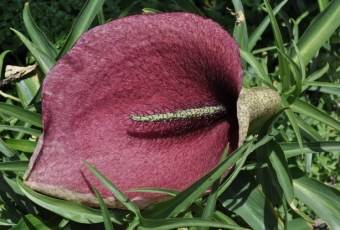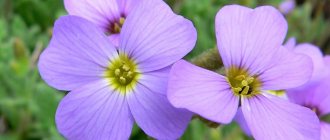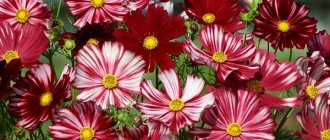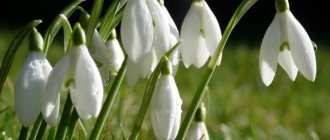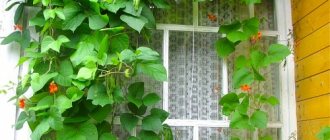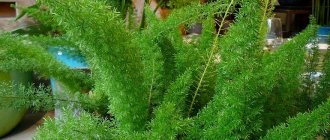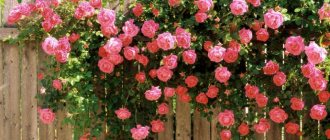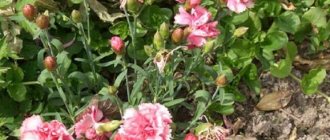Flowers are a beautiful creation of nature, besides their pleasant appearance, they have their own and unique aroma. With the help of smells, flowers attract insects for pollination, helping them subsequently give seeds. The scent can also serve as a warning for insects and animals. Few people wonder why flowers smell. The scent of each flower originates inside the buds and spreads around thanks to the sunlight - when the flower blooms. In other words, the smell comes from the essential oils inside the flower.
The process of creating a scent is actually very simple: the evaporation of oil from exposure to temperature. A lot of flowers smell really nice, drawing attention not only by their appearance, but also by creating a scent in the air.
Chlorophytum
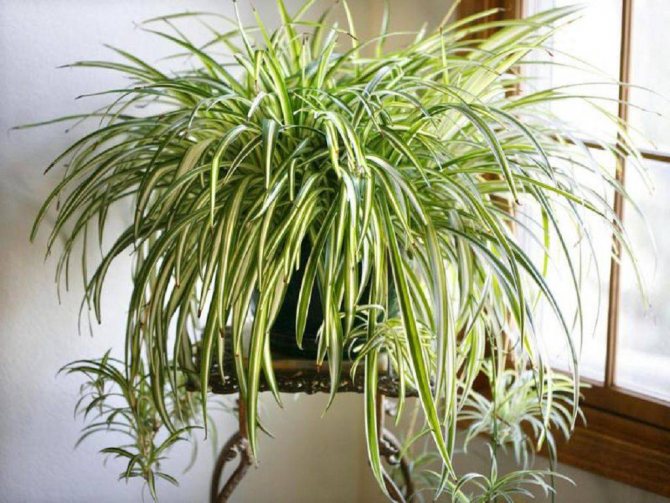
This plant destroys formaldehyde and various resins. It is especially good to have such a flower in city apartments, where there are constantly admixtures of exhaust gases in the air, which are destroyed by this plant.
Also, the flower:
- absorbs pathogenic microbes;
- saturates the room with oxygen;
- regulates the humidity in the room.
Chlorophytum is not whimsical to care for. It can live for a long time in dry soil and in a room without lighting. It is noticed that air with unfavorable substances has a better effect on the growth and reproduction of chlorophytum.
For healthy plant growth, it is recommended to place it in a warmer room. It is allowed to put it in the kitchen next to the gas stove.
Chlorophytum should be watered frequently and abundantly, otherwise the leaves will begin to dry out. But if you pour it, then the flower will turn black.
Plumeria
Plumeria in nature is a tall tree with long, oval-shaped leathery leaves of bright green color. The homeland of culture is the tropics in the Pacific Islands, the Caribbean, the South American continent and the southern part of the Asian region.
Leaves and five-petal flowers with a strong pleasant aroma, similar to stars with rounded edges, collected in dense inflorescences, give the tree a decorative effect. The color of the flower is delicate, warm shades, and in the center is golden yellow, which makes it especially attractive.
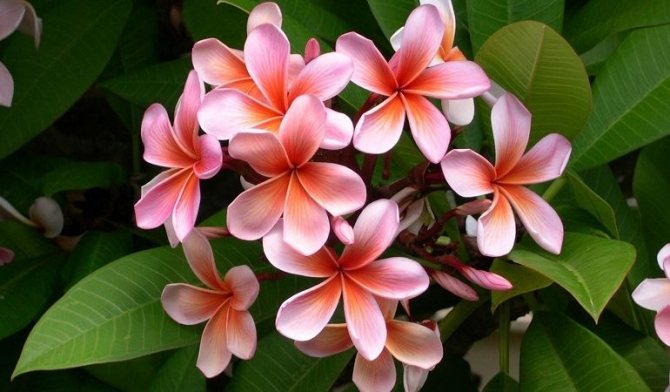

The flowers emit their strongest aroma before sunrise and in the evening, when the sun is hidden. Interestingly, in the bright sun, the flowers almost do not smell.
On a note! The smell of flowers attracts insects in search of nectar, but there is no nectar in plumeria flowers! But the scent played its role - the plant was pollinated.
It is impossible to say that there is a specific smell in the aroma - it contains jasmine and citrus notes, the aroma of forest lily of the valley, spices and gardenia flickers.
In temperate climates, the culture is grown indoors as an ornamental tree.
Interesting Flower Facts:
- in Nicaragua, he is the symbol of the nation, his image is on banknotes;
- petals can withstand temperatures up to 500 ° C;
- is a sign of marital status in Polynesia - if a woman has it behind her right ear, then she is looking for a couple, if behind her left ear, then there is already a couple;
- in the culture of India it is a symbol of immortality - a tree is planted near temples, in cemeteries, so that fallen flowers decorate the graves.
Spathiphyllum
A beautiful houseplant with wide green leaves and white flowers. Can absorb large amounts of toxins and ammonia vapors.
Spathiphyllum destroys mold spores, trichlorethylene vapor and moisturizes the air well. During flowering, it emits pollen, so it is not recommended to place it in a room where there is an allergy sufferer.
The flower is not picky about lighting, so it is undesirable to place it on a windowsill in direct sunlight. Diffused light will suit him, but if it is not enough, then the flower will stop blooming.
The air temperature should be moderate, but hypothermia should not be allowed, otherwise the plant will die. To maintain moisture, you need to regularly spray the leaves with water. Watering should be done frequently to keep the soil in the pot constantly moist.
Aristolochia or Kirkazon (Aristolochia)
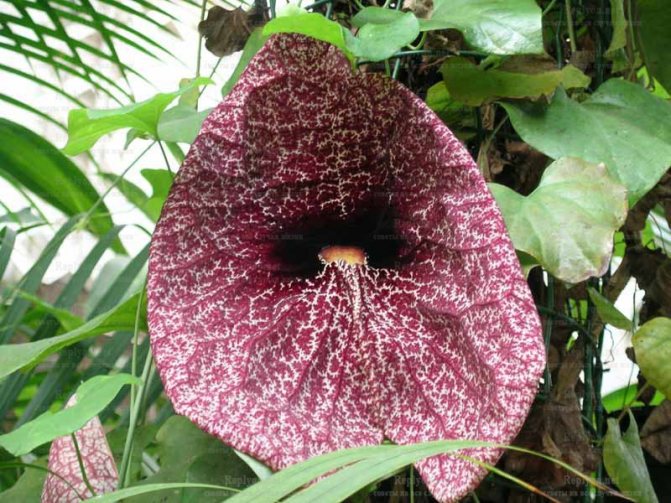

A climbing plant with dense greenery, oval leaves and a smelly flower. Large-flowered Aristolochia has flowers about 20 cm in diameter and 50-60 cm in length, exudes a strong smell of carrion, which insects like very much. The flowers themselves are "with a secret": when the fly decides to get out of the flower, having eaten nectar, the villi covering the surface of the cup do not allow them to get out. The insect flounders for a long time until it pollinates aristocholia. The villi wither under the influence of pollen, and the fly moves on. The flowers themselves look very impressive against the background of dark green foliage - the correct heart-shaped shape and maroon color with white veins, therefore, the plant often serves as a decoration for the landscape.
Geranium (Pelargonium)
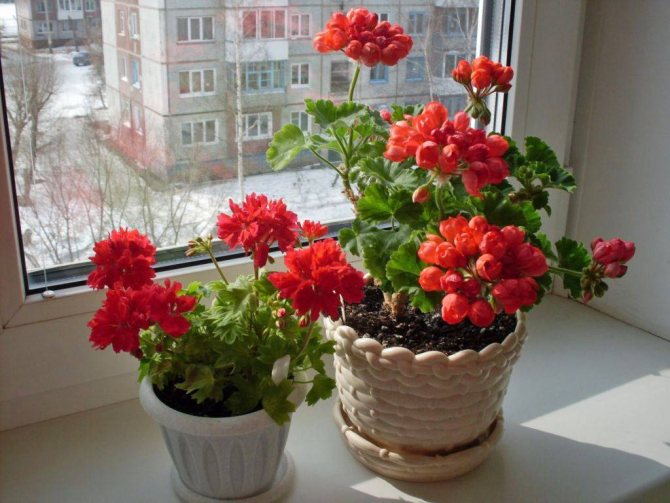

This plant has a specific smell that not everyone will like, but it is still one of the most common indoor flowers.
Geranium releases essential oils that disinfect the air well and have a soothing effect. Can fight staphylococcus and streptococcus.
People with allergies need to treat the plant with caution. The essential oil of the flower helps fight colds.
Geranium in care is not a picky plant. The air temperature is moderate, but you should not leave the flower in a cold room in winter. The main thing is that it is in a well-lit place, since its growth depends entirely on the sun's rays.
Geranium loves dry soil, so you need to water no more than twice a week - with care, not getting on the leaves of the plant, as they may die. If properly cared for, pelargonium will bloom all year round.
Dead Horse Lily (Helicodiceros muscivorus)
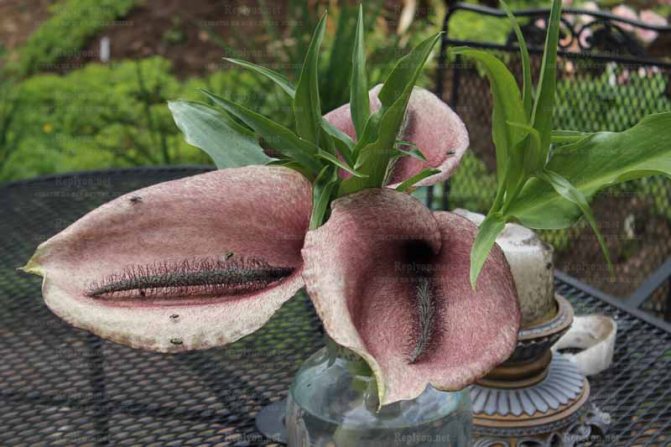

The pale and tough integumentary tissues of the lily are covered with dark, dense hairs, which resembles the peeling hair on a dead animal. The flower exudes a rotting smell, which attracts corpse flies and meat flies.
On the first day of flowering, stigmas of pistils open, that is, female stigmas, flies bathe in nectar, lay offspring. The next day, the stigmas of the pistils close, the stamens open, the sticky bodies of insects are soiled in male pollen, the smell of which prompts the insects to flee, that is, to another stinking flower. This is how cross-pollination occurs.
On cloudy days, when there are practically no insects, Helicodiceros is able to raise the temperature so that its smell spreads much further, attracting other flies. It grows in the northwestern part of the Mediterranean region.
Dracaena
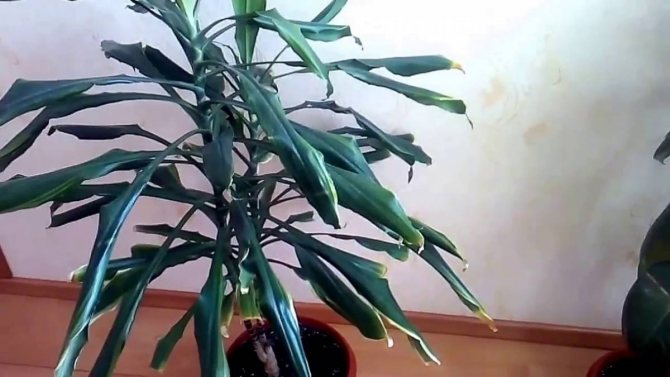

Outwardly, the plant looks like a palm tree. There are about 40 types of flower, which differ in height, color and shape of the leaves.
Dracaena well cleans the air from particles of household chemicals and pharmacaldehyde, and also destroys exhaust fumes that can enter the apartment from the street.
The plant leaves contain hazardous substances for pets. Dracaena loves well-lit rooms, avoiding direct sunlight, but you need to pay attention to the type of flower. A plant with dark leaves does not require a lot of light.
The flower loves moisture, so it needs to be watered frequently and the leaves are constantly sprayed. Dracaena is thermophilic, it should be protected from hypothermia.
Aromas of white flowers in perfumes: do not escape from the captivity of illusions
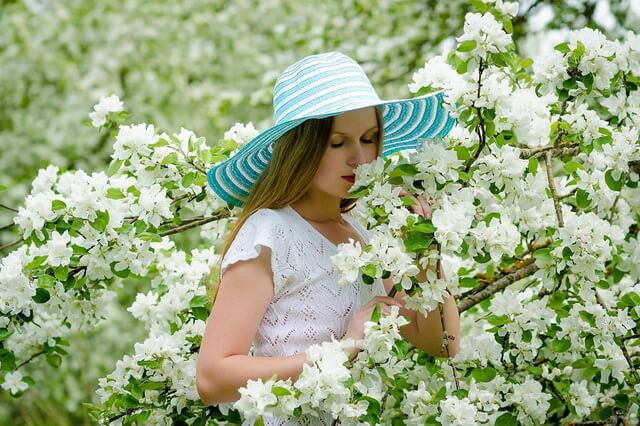

Why is white so captivating with its freshness and fragility? If you look at it, then we are fascinated by its deep meaning and power. White shades symbolize prosperity, purity and excellence. They talk about the present, true, singing joy and eternal fidelity. Therefore, at the subconscious level, each of us is drawn to the enchanting aromas of white flowers, warm creamy tones and sparkling icicles of cold shades.
White flowers in perfumery
White flowers are always surrounded by attention and admiration. They are given to beloved women, mothers, brides, newborns. They are used to decorate churches on the brightest and most significant holidays.


Aromas with notes of white flowers enchant with purity and freshness, capturing illusions.
In perfumery, white flowers are present in many compositions, being a real decoration. And again we are charmed by cleanliness and freshness. But in this case we are in the captivity of illusions. Because all white flowers used in fragrance formulas tend to have strong and deep scents.
Despite the fragility and tenderness of the petals, they show their extraordinary character, giving the miniatures originality of sound, sweetness of shades.
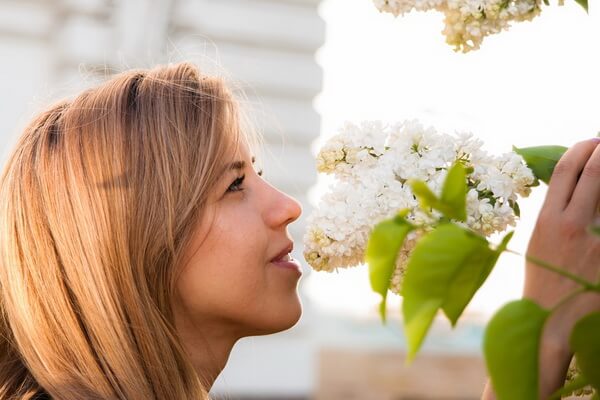

The perfume with the scent of white flowers is sensual and gentle.
The perfume with the scent of white flowers is sensual and gentle. They are created for women's compositions, emphasizing the best qualities of the beautiful half of humanity.
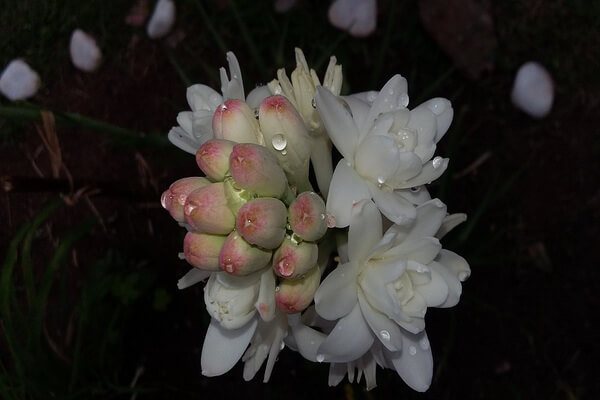

The aroma of tuberose is most often present in the perfume pyramid with notes of white flowers.
Most often, tuberose, jasmine, gardenia and orange flowers are present in the perfume pyramids.
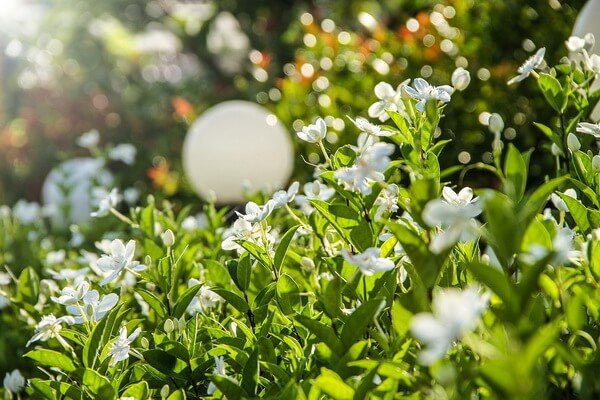

The enchanting scent of gardenia is very popular in perfumes with notes of white flowers.
Less commonly - mandarin flowers, lilies of the valley, lemon flowers, mock orange, lily, honeysuckle.
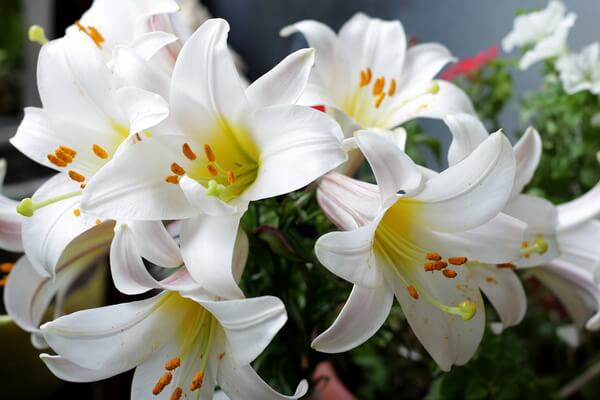

The scent of lilies and lily of the valley is also often used in perfumery.
There are also exotic white flowers - frangipani, tiare, queen of the night, tangerine flower, karo corundum. They are rarely used because they are expensive.
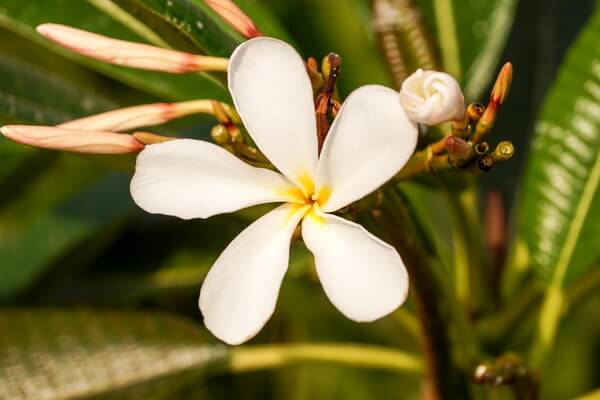

The presence of notes of exotic frangipani significantly increases the cost of perfume with the scent of these white flowers.
And the presence of such jewelry in perfumes significantly increases the cost of the perfumes themselves. But in selective compositions, they take pride of place, giving the spirits a divine sound.
Fragrances with notes of white flowers
Perfumers put a broad concept in the concept of “white flowers”. Pronounced floral accents, sweetness, sensuality, heady depth captures instantly.
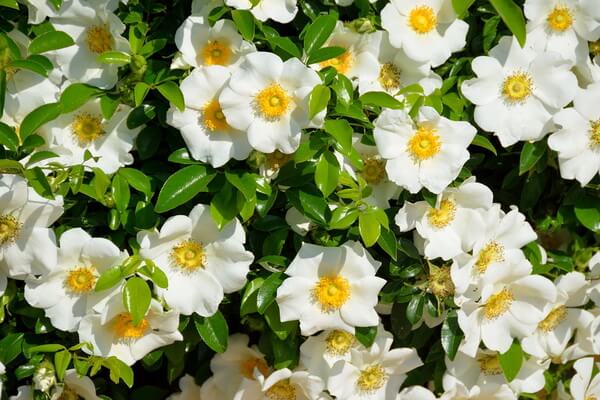

White flowers in perfumes captivate with languid and viscous sweet notes.
Women cannot resist magic fluids. For men, there is nothing more attractive than a woman wrapped in a cloud of floral scents.
Initially, we approach white colors as a source of freshness and coolness. And they captivate us with languid and viscous sweet notes. Does the perfume sound passionate, dynamic, bright? This is jasmine. The aroma excites with a dark depth, intoxicates like champagne? This is sambac.
The perfume with the aroma of white jasmine flowers sounds passionate, dynamic and bright.
Large-flowered jasmine resembles the smell of buckwheat honey. It is a pure passion that you want to smell over and over again.
Floral-powdery jasmine creates a flair of sophistication and aristocracy. He gives all his strength in an elegant perfume for a lady with an extraordinary taste.
And the mysterious and almost mystical beauty of white roses?
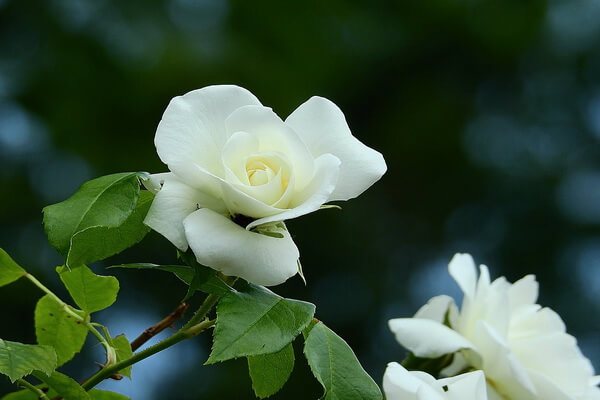

White roses are very popular in perfumery.
White flowers go well with fruity motifs, animalistic (animal) notes, woody and green shades.
Intertwining with other components, aromas with notes of white flowers draw us into their illusory world. And we easily succumb to their spell.Probably because life becomes more interesting this way. Where there is mystery, there is room for faith, hope and love.
Aloe
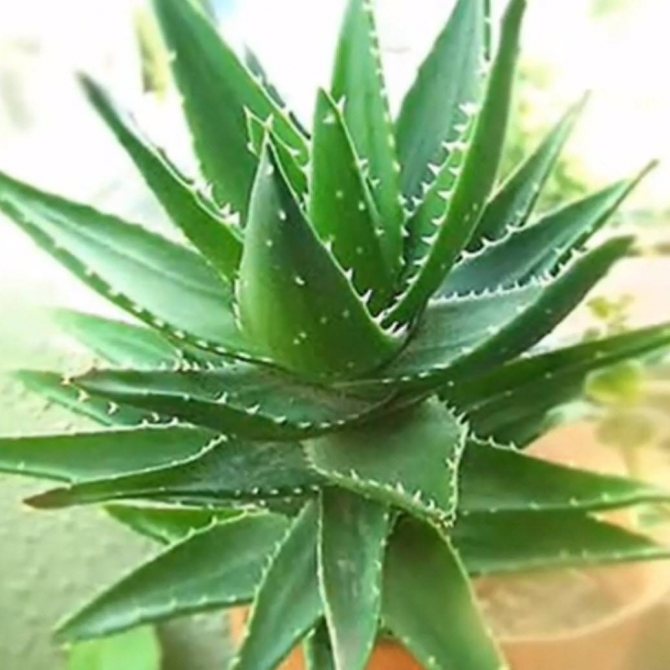

Aloe leaf juice contains a large amount of vitamins and nutrients that have healing properties for the human body, and the plant itself cleans the air well in the apartment.
It absorbs all the formaldehydes that are generated in the room. The leaves of the flower secrete useful substances - phytoncides. They have a beneficial effect on the human body, strengthening the immune system and improving cerebral circulation.
Aloe does not require special attention to itself. It grows well in a room with unfavorable air. Loves good lighting and direct sunlight.
The air temperature can remain moderate. Water the flower with warm water abundantly, but not more than once a week, remembering to wipe the leaves from dust. In winter, one plentiful watering per month is enough.
Garden plants with a wonderful aroma
Despite the fact that many plants give off a strong and enchanting scent during flowering, only a very few species act as natural perfumes, perceptible from a distance. It is worth paying attention to this property, because in a fragrant garden you can spend your time even more pleasantly. It has long been known that the smell of flowers affects well-being and health.
A garden that mixes amazing scents of flowers and greenery, a dream that is easy to come true. There is a certain group of plants that gives off an intense aroma that bewitches not only insects, but also people. It is worth using this and choosing fragrant plants, especially that such species are at the same time, unusually attractive and, they are easy to arrange in gardens of various types. The smell of flowers can also have a beneficial effect on health - it has an anti-stress effect and improves mood.
Fragrant plants - where to plant?
Obviously, it should be understood that not every plant gives off such a strong odor that it delights their sense of smell when walking through a large area of the garden. therefore scented plants should be planted in certain places:
- near the house on the windows (then the aroma can be felt, even being in the house);
- near benches and other architectural elements such as terraces or gazebos;
- on the balcony;
- in places where an unpleasant odor already reigns, for example, near a composter;
- trees and shrubs can be used as fencing off high-traffic roads. In addition to a pleasant odor, the species mentioned below can additionally form a dense wall, limiting pollution and noise to some extent.
Ficus
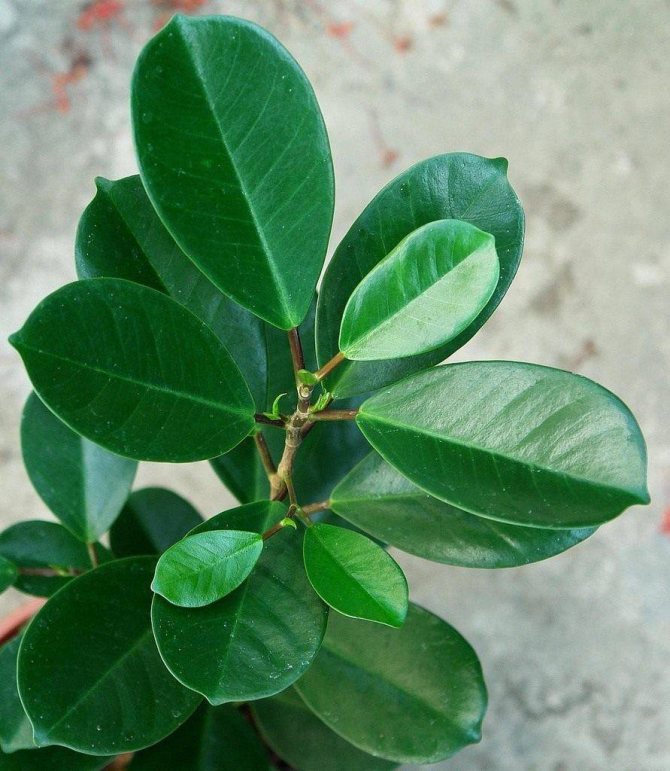

There are several types of ficus. All of them reach large sizes and live for several decades.
The flower's large leaves effectively purify the air by absorbing harmful substances such as formaldehyde, benzene, ammonia and carbon dioxide. The plant removes dust from the air in the room and saturates it with oxygen.
Some types of ficus can contain poisonous sap. You need to beware of getting it on the skin. This plant is dangerous for allergy sufferers.
Features of flower care depend on its type. Plants are very fond of humid air. Leaves must be regularly sprayed with warm water and wiped from dust.
Ficus does not tolerate direct sunlight and abundant lighting. Watering the flower depends on the season: in summer it is more abundant and often, up to 3 times a week, in winter the ficus should not be poured, once a week is enough. It is important to remember that this plant does not like to change its location frequently.
What types to use? Fragrant garden plants
Nice smelling annuals and perennials
One of the most famous fragrant aromatic plants is Levkoy... Delivers an amazing, pleasant aroma, especially in the evening. In addition to it, several other species deserve attention.
Levkoy, or Mattiola (lat.Matthiola)
Description: Usually reaches 30-40 cm in height, small flowers from white to mauve or yellow flowers with four petals. They give off an intense odor especially in the evening and at night;
Bloom: from July to September;
Application: for any type of garden, on a balcony, on flower beds, under a window.
Sweet pea (lat.Láthyrus odorátus)
Description: climbing annual, can grow up to 2 m in height, forms small elliptical leaves. The flowers are irregular, of the five-fold type, they can have different colors - most often they bloom in white, pink and purple. It is grown for its fragrant aroma, which gave it its name.
Bloom: from June to August;
Application: decoration of fences, for all types of decorative lattices, can be planted in a flower bed.
Lakfiol or jaundice Chery (lat.Chiranthus cheiri)
Description: a biennial plant, usually 50-60 cm in height. Plant with large yellow, orange, purple, velvety brown and variegated cruciferous flowers;
Bloom: from April to June;
Application: on balconies, on flower beds, for cutting a flower.
Decorative tobacco (lat.Nicotiana alata)
Description: perennial plant, grows up to 50-80 cm in height. The leaves are elongated, small, the flowers are collected in an inflorescence - a panicle, open at night and then smell the most intense. Their color can be white, pink, cream;
Bloom: abundant from June to October;
Application: flower beds, container growing, fence decoration.
Fragrant aromatic bulbous and perennial plants
Bulbous plants and perennials usually give off a pleasant aroma, but some species stand out from others. In the group below, they could not ignore such favorites as hyacinth, lily of the valley and lily.
Lily (lat.Lílium)
Description: depending on the variety, they can be of different heights, as a rule, no more than 150 cm. The decoration is large, with bent tops, tubular or cup-shaped flowers of various colors. Lilies give off a strong, almost suffocating odor;
Bloom: mainly in summer;
Application: for flower beds, for individual parts of the garden.
Dittany (lat.Dictamnus albus)
Description: can grow up to 120 cm in height. The leaves are large, pinnate with serrated edges. The flowers are large, collected in racemose inflorescences. The whole plant emits a lemon-like scent. On hot sunny days, essential oils can catch fire. A blue flame appears for a short time, which does not damage the plant.
Bloom: June - July 40-45 days;
Application: for flower beds, planting in groups, for naturalistic and country gardens.
Hyacinth (lat.Hyacínthus)
Description: the plant grows to about 20-30 cm in height. The decoration is large, collected at the top of the stem in the form of a brush, flowers. Their color depends on the variety (most often they bloom in white, blue, purple, pink and red). Hyacinths give off an intense, slightly suffocating aroma;
Bloom: from March to May;
Application: on flower beds, on rock gardens, for pots, for decorating apartments - on the windowsill.
May lily of the valley (lat.Convallária majális)
Description: it is a short plant, about 20 cm high. The decoration is both small, bell-shaped white flowers that form an inflorescence, and large lanceolate leaves;
Bloom: from May to June;
Application: flower beds, groundcover, cut flower, rustic garden.
Pion (lat.Paeónia)
Description: depending on the species, it can reach 80-120 cm in height. Produces large, feathery leaves and attractive white, pink, red flowers. Flowers in diameter can be 15-20 cm. Peonies are also loved for their pleasant aroma;
Bloom: May June;
Application: for single or group plantings, for high flower beds, for the park, for cutting a flower.
Begonia
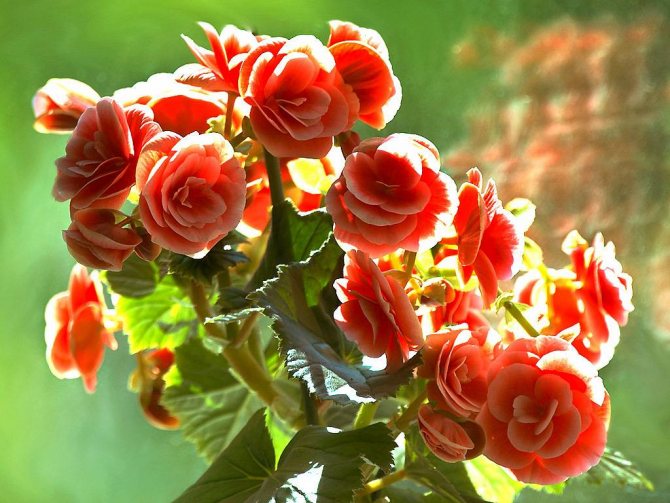

This plant is one of the best destroyers of mold spores and microbes in the indoor air. It effectively absorbs dust and humidifies the air.
In a room full of electrical appliances, begonia can cope with their radiation. It is a light-loving plant, but burns can form on the leaves from direct sunlight.
A flower needs moist air.It is impossible to spray the leaves, but it is necessary to regularly wipe them from dust so that the plant does not lose its beneficial properties.
Water should be plentiful, especially in summer. In winter, the plant needs a warm, humid climate, and watering is reduced to once a week. Begonia should not be often rearranged from place to place, it loves constancy and peace.
Ylang-ylang
As an ornamental culture, ylang-ylang (fragrant kalanga) is not of interest to gardeners - it is a nondescript evergreen tree with “fading” flowers. Flowers of a greenish-yellow or pale pink color really seem to be drooping and fading, but they smell so that their aroma cannot be confused with other smells - it is so strong and memorable.


The characteristic rich scent of flowers contains a whole bunch of aromas - you can catch notes of jasmine, neroli, gardenia, orchid.
The natural environment for the growth of culture is the warm regions of Southeast Asia, northern Australia.
Interesting Facts:
- an Indonesian wedding must have a garland of fresh ylang-ylang flowers;
- in religious and magical rites in the Philippines, they use the scent of dried flowers when they are burned;
- ylan-ylang is considered a strong aphrodisiac, and garlands of fresh flowers are placed at the head of the newlyweds;
- the aromatic oil of the plant was used in the harems of the Middle East;
- in Victorian England, flowers were used as pomade;
- ylang-ylang began to be used as a scent for alcoholic spirits in France and, which is important in perfumery, its aroma goes well with other perfume smells.
Dieffenbachia
Can reach large sizes in height. The large leaves of Dieffenbachia absorb harmful substances (xylene and toluene), which are emitted by floor coverings and paintwork. The flower also destroys staphylococcus, which is dangerous to human health. It should be remembered that the plant is poisonous, so if you have children or pets, it is better to refuse it.
Dieffenbachia is a plant that requires special attention. It likes good lighting, but you should avoid direct sunlight, otherwise the patterns from the leaves will disappear.
A warm indoor climate is needed for good growth. To maintain moisture, you should constantly wipe the leaves with a damp cloth. In summer, make sure that the soil of the flower is moist. In winter, you need to water the plant less.
Sexy Orchid Drakaea glyptodon
The Sexy Orchid (Drakaea glyptodon) is the most "unusual" species. The spikelets of a given one resemble the body of a certain species.
Plus, the sexual one emits the same external secretion products (pheromones) as the female. It is curious that the flower begins to bloom at the time of the wasps breeding. Males swoop down on inflorescences. They transfer pollen that has got on the body of the wasps from one flowering grass to another. Under natural conditions, sexual is found only on the Australian continent.
— woody predatory shrub.
In the wild, it lives in the Philippine Islands. The plant develops up to 1.5 m in height. Leaves are leathery, almost sessile. The flower is similar to the shape of a volumetric jug. feeds on insects that fall into its pitcher trap. The average size of the "jug" is 25 cm long and 12 cm wide. The largest of the discovered "jugs" had a volume of 1.5 liters.
Did you know?
This interesting huge flower was first discovered in 2000 on the island of Aalavan. The very first information about the plant was received from missionaries who had previously visited the island. How Nepentes Attenborough managed to survive to our times is a mystery to this day..
Herbaceous tuberous, developing in well-lit forest glades. The specimen is widespread in Europe, North Africa, and the Caucasus. Height is 20-45 cm. 3-5 leaves develop on the stem. The inflorescence is dense, multi-flowered, ovate, short.The monkey orchis bears fruit in June. Propagated by seeds. The shrub does not form continuous thickets. When flowering, the herb has a pleasant orange scent. This flower grass is the rarest species, many of its populations have been destroyed.
Another tropical flower, found in the form or. The foliage remains green throughout the year. Liana spreads on rocky slopes, and in forests lives on tree trunks. The length of an adult liana can be up to 10 meters. The leaves are oval, pointed towards the end. The surface of young leaves is shiny, later they become dull. Flowers are bisexual, star-shaped, collected in umbellate panicles. Inflorescences stay on the shoots for a maximum of two to three weeks. The flowers give off a strong odor. Viscous translucent nectar can be observed on the inflorescences.
Sansevieria


The people also call the flower "mother-in-law's tongue". The plant absorbs hazardous nitrogen and formaldehyde vapors, in addition to ammonia impurities. The leaves secrete useful substances - phytoncides, which destroy streptococcus and help fight viruses and microbes.
Sansevieria is a rather unpretentious house plant. It is able to withstand both long drought and excess moisture. Can survive at any temperature.
For healthy plant growth, a lot of light is needed, but it is recommended to protect it from direct sunlight. If there is not enough light, the flower stops growing.
Watering should be done constantly, avoiding drying out, in winter watering is reduced. Periodically, it is necessary to wipe the leaves with a damp cloth.
Tuberose
The plant owes its name "Tuberose" or "Tuberous Polyantes" to the structure of the root system (in Latin, the word "tuberosa" is derived from the word "tuber" - tuber) and has nothing to do with the rose.
For many peoples, the flower is called "the queen of fragrances", "the king of fragrances" - this is due to the distinctive feature of the culture brought from Mexico. Tuberose is valued for its beautiful snow-white flowers and for its sweet, delicate aroma with many shades, incomparable with anything. Someone considers him refined and sophisticated, but for someone he seems cloying.
Interesting about the flower:
- for the production of 1 liter of tuberose oil, about 1000 kg of flowers are required;
- tuberose oil is one of the most expensive oils in perfumery - 1000 ml of oil costs about 12,000 dollars;
- the aroma acquires maximum saturation at night;
- tuberose was the favorite flower of King Louis XIV of France;
- flowers after cutting continue to accumulate aromatic substances.
Scheffler
There is a wide variety of species of this flower, but all are suitable for indoor cultivation.
This plant absorbs and neutralizes nicotine and tar from tobacco smoke. It destroys formaldehyde and benzene.
The flower is very light-requiring. It is not afraid to change its location, so it can be moved to more sunny places, but it should not be exposed to direct rays.
The humidity in the air will not affect the plant, but it will grow better in rooms with higher humidity. Irrigate the leaves regularly with warm water. For watering the flower itself, it is recommended to use a liquid at room temperature. You need to moisturize moderately: do not overfill or overdry the soil. If the sheffler has a lot of moisture, she will die. In winter, watering should be reduced.
Choosing the right indoor plants can significantly improve the air quality in your apartment.
Of course, each plant needs to be given time to care, but if you choose unpretentious species, you can make the air cleaner without making any special efforts. But keep in mind that some house plants can be dangerous for children and people with allergies.
dm-
| Pelargonium zonal |
“They say that to exude a scent means to waste yourself,” wrote the poetess Irina Feshchenko-Skvortsova.Green friends grow in our flowerpots, who give us a part of their soul - a noble and exquisite fragrance. So who are they, the most fragrant houseplants?
Plectrantus
(indoor mint). This plant with curly light green leaves is capable of filling the house with an amazing scent of mint - you just need to touch it. Loves light rooms and good watering. Grows quickly when handled with care. Belongs to the same family as peppermint. I haven’t come across any official records regarding the consumption of food, however, at my own peril and risk, I sometimes add it to tea and ice cream. But what's true is true: Plectrantus scent has soothing properties and promotes good sleep.
| Indoor rose |
Muraya (murraya) paniculata
... A single flower from this rare Japanese tree can scent a standard room of 18 square meters. Since the smell of such a plant has a long range. The aroma of muraya is complex, similar to the smell of jasmine and lemon flowers at the same time. They say it has a beneficial effect on the heart. Provided the plant of Japanese emperors is properly cared for and well lit, it can bloom all year round. However, flowers, like all representatives of the rutaceae family, keep only a day, a maximum of two.
Sansevieria
... All varieties of this popular indoor phytogenet produce unusually long stalks that bloom in the evening and emit a pleasant and slimy aroma reminiscent of the scent of a lily. Sansevieria (sansevieria) blooms in spring and / or autumn. Each flower fades in the morning. However, there are many of them on the peduncle, so you can enjoy the fragrance for a long time.
Indoor essential oil rose
... Has a bright and delicate aroma. It is believed to have a good effect on well-being and is a powerful aphrodisiac. The smell of this flower can be heard wonderfully in a small room.
Indoor jasmine (sambac)
... Another aphrodisiac is a smelling houseplant. It blooms with small white flowers, but how richly they are fragrant! When caring for homemade jasmine, you need to take into account that this is a climbing plant, so it needs support.
Lemon geranium
... In fact, all geranium and pelargonium leaves emit odors. But in the same zonal pelargonium, it is specific (although the essential oil of this particular plant is used in perfumery). But the leader of the scent of living fragrances can be called lemon geranium, the leaves of which exude the goodness of lemon. (If you walk past the market, it is often sold by older women from their home collections.) There are varieties that have a natural aromatic composition of lemon-rose, lemon-lemon balm, lemon-wormwood, and even Coca-Cola.
Pelargonium zonal
... And yet this beauty cannot be ignored. It is essential in a living home fragrance collection because its leaves serve as an indicator of well-being. If she smells unpleasant for you, then this is an indicator of psychological well-being. If, on the contrary, the smell seems attractive - in the emotional sphere, not everything is ok. Most likely, you are overworked - and you need peace.
Eucalyptus
... All varieties of this plant emit a fragrance. But the most striking of these indoor trees is lemon eucalyptus. With a small touch, even on one leaf, it is able to saturate a standard medium-sized room with aroma.
| Myrtle: "fragrant carpet" |
Common myrtle
... One touch to the small, dark green leaves of this house tree or shrub fills the room with a conifer-like scent.
Gardenia
... She's an English rose. The languid languid fragrance of this green miracle cannot be forgotten. It is often included in perfume compositions and is used as a solo scent. Taking care of this houseplant is challenging, but well worth the effort. Caution! There were reports on the Internet that this flower needs to be fed ... with meat.If you want to send this exotic to another world, use this advice. If you want him to stay longer on the windowsill, in no case do this: even small particles of meat clog the soil. It is more correct to use meat water: rinse the container where there was fresh meat or fish, drain into a bottle. And, before watering the plant, thoroughly filter this water through cheesecloth (in order to remove meat or fish pieces).
Spicy plants
... Namely, noble laurel, rosemary, which can be eaten, are great for keeping at home and fill the room with a pleasant aroma.
Citrus trees
... Everything glows in them with pleasant notes: both leaves and flowers. Indoor lemon, tangerine, calamondin, orange and even grapefruit are grown at home.
Cactus
... Oddly enough, but these thorns can also become sources of home incense. Some types of astrophytums (emit the smell of pineapple), echinopsis, hymnocalycium have fragrant flowers.
Conifers
... Indoor plants that smell can be safely attributed to representatives of the conifer family. However, it is extremely difficult to maintain them at home - you need to spray a lot, protect from dry air. The most "surviving" houses are considered cypress, cypress, araucaria. But they also need to be looked after very carefully.
Such a fragrant bouquet can be collected on one windowsill. Smelling indoor flowers are certainly natural air fresheners. Unlike synthetic products - "stubs" of unpleasant odors, based on a combination of artificial substances, home green friends do not destroy, but improve health. And another important difference with household chemicals: the aroma of houseplants does not irritate the sense of smell (smelling synthetics can ruin it). And the main thing in such "spirits in flowerpots" - they are a gift from Nature itself.
home-plant.
There are flowers in the world with a disgusting, sickening, disgusting smell. Their "aroma" is so monstrous that it causes stomach cramps and completely discourages the desire to admire nature!
Witch lily (Voodoo lily, Drakunculus vulgaris)
| Don't be fooled by the deceptive beauty of this delicate pink flower! This lily belongs to the same family as the Calla Lily, but unlike the latter, the use of the Witch Lily in flower arrangements should be avoided. It emits a disgusting smell of rotting flesh that attracts flies and other insects. It is unlikely that such a bouquet will allow you to invite guests to your house. |
Cadaveric lily (Rafflesia arnoldi)
| The shape and color of the cadaveric lily is ideal from the point of view of mimicry. The development of the bud can last for months, and the flower itself blooms for only a few days. In the tropical forests of Indonesia, the world's largest Rafflesia arnoldi was found - about a meter in diameter and weighing about 12 kg. The plant has no leaves, stems or roots. You should not get too close to him - Rafflesia exudes a pungent smell of decaying flesh. Once you get acquainted with the Corpse Lily, you are unlikely to wish to smell this flower again. |
Toad Flower (Stapelia Gigantea, Dead Meat)
| This South African succulent has a fleecy, cactus-like flowers and a foul smell of rotting flesh that attracts insects. The five-petalled flowers can be up to 40 cm in diameter. If you are comfortable with the fetid aroma of the stapelia, you can try to plant these flowers on your windowsill - they are easy to care for, unpretentious, and the only thing you have to take care of is good lighting and dry soil. |
Dead horse (Helicodiceros flycatcher, white lily Arum)
| The Arum lily can often be seen on the Mediterranean coasts. One of its names is due to the fact that the flowers emit an unpleasant smell of decaying animal flesh. This disgusting scent attracts flies, which lay the larvae in the flower bowl.A dead horse has another unique property - to control its temperature using thermoregulation processes. |
Aronik titanium (Amorphophallus titanum)
| This plant can grow to a height of over three meters, making it one of the largest and most bad-smelling flowers in the world. However, despite the fact that titanium arum exudes a terrible smell of decomposing flesh and rotten eggs, people are ready to travel to the other side of the world to see the amorphophallus titanum bloom - after all, this is a truly rare sight. The plant may not bloom for many years, and the bud, which has finally blossomed, lives only 1-2 days. If you are not disgusted by the specific smell of rotten meat, you can, having the courage, visit the largest botanical gardens in different countries and take a look at this unique plant. In addition, titanium arum can be found in the rainforests of Indonesia, although not often lately, since the flower is an endangered species. |
If you are more attracted by beautiful fragrant bouquets to order or if you have questions, original ideas and suggestions, call us +7... Our florists will be happy to advise you and arrange delivery.
The most fragrant flowers for your garden
Nature has endowed some plants with the beauty of flowers and inflorescences, others have not endowed with a spectacular "appearance", but gave them a wonderful smell.
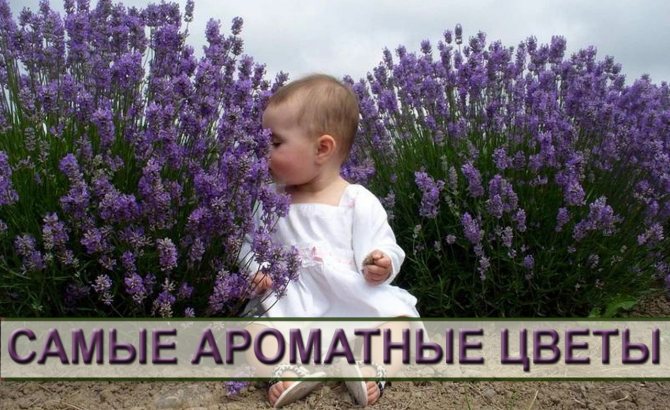

Today, both those and others are involved in the creation of fragrant flower beds. In the compositions, not only their beauty is manifested, but also a peculiar bouquet of aromas is created, which envelops the dacha with a light veil.
Some scents become our favorites, so from year to year we sow seeds and plant seedlings of plants with the aroma we like. Some varieties of fragrant flowers not only serve as decoration, but also have the ability to scare away harmful insects from garden and vegetable garden crops.
Carnation
There are about 400 varieties of carnations, in a wide variety of colors and shades, including pink, white, red, or a mixture of pink and white. The unpretentious clove produces pleasant greenery that does not fade and remains fresh for quite some time. High varieties of cloves are mainly used for cutting. Carnations are both annual and perennial, and this fragrant flower is best planted in areas that are well lit by sunlight.
Gardenia
Every self-respecting fragrant garden should have in its assortment gardenia, an evergreen shrub with large white or yellow flowers. Another nice feature of the gardenia is that it is suitable for both the garden and indoor cultivation.
Ordinary tobacco
Possesses lush fresh greenery and beautiful pink and white flowers that fill the garden with a pronounced sweet scent. The flowers of the plant bloom in the evening, so it is best to plant the tobacco closer to the terrace or bedroom window, as the smell of flowers is most felt at night.
Autumn clematis
Thinking about how to decorate the garden in the fall? Try planting autumn clematis, which is a large vine, literally strewn with lovely white fragrant flowers (the length of the vine reaches 7.5 meters). Clematis prefers fertile soil, needs regular watering and bright sunlight. When planting autumn clematis, it is preferable to choose a place so that the root of the plant is in the shade, and the vine itself is on a well-lit sunny side.
Oriental lily
A delicate and refined lily can rightfully bear the title, the most fragrant flower, capable of filling the entire garden and its surroundings with its fragrance. Oriental lilies bloom in mid-summer and bloom until September. The most beautiful lilies are white, pink and yellow. Great as cut flowers.
Garden phlox
Perennial phlox, are compact lush bushes, covered with small beautiful flowers of white, pink, scarlet, lilac and blue. Phlox bloom towards the end of the summer season. The delicate sweetish scent of phlox is most clearly felt on warm sunny days.
Garden rose
Almost every gardener has beautiful and noble roses in his assortment. Roses are presented in many colors and shades, ranging from dark cherry, almost black, to snow-white. Roses are very popular with flower growers.
Different varieties of roses differ not only in their colors, but also in the variety of aromas - there are roses with a floral or fruity scent, in the aroma of other varieties there are musky and citrus notes.
Sweet pea
Sweet peas got their name for a reason, distinguished by a bright persistent aroma. It is a climbing plant with small delicate flowers of various shades, some types of peas have a two-tone color.
However, if fragrant flowers for the garden are your goal, then you should be aware that some varieties of peas are practically odorless.
May lily of the valley
Despite the fact that it is very modest in size, this does not in any way affect the severity and intensity of the aroma that its white or pink bells emit. Lilies of the valley are extremely easy to care for, all you need is to plant flowers somewhere in a shady corner of the garden.
Hyacinth
Hyacinths prefer the sunny side or partial shade, and grow beautifully sheltered from the wind by other garden dwellers. These are early spring flowers. While all other plants are just getting ready to bloom, hyacinth is already filling the air with a delicious delicate scent. Hyacinths are planted in autumn, in a sandy fertile soil with good water permeability.
Iris
Irises, represented by almost all the colors of the rainbow, add color and life to any garden. They differ in a variety of aromas. The scent of irises can contain fruity and floral notes, as well as anise.
Common lilac
Lilac is one of the most widespread garden plants, flowering in early spring. Lilac is distinguished by its unpretentiousness to growing conditions, but, at the same time, it does not like shade very much. The plant is a luxurious shrub covered with fragrant inflorescences of white, lilac and purple flowers.
Heliotrope
When heliotrope blooms in the garden, invite your friends over and ask them what the scent of its flowers reminds them of. Opinions vary as to whether heliotrope smells like grapes, vanilla, cinnamon or cherry pie. Although it doesn't matter, the main thing is that you will definitely love the pleasant smell that the lovely purple, blue or white flowers of this plant give off.
Lavender
Lavender is a perennial herb that is an evergreen shrub or subshrub. Since ancient times it has been famous for its aromatic properties. Grows best on the sunny side and prefers soils with good water permeability. Lavender flowers emit a light and delicate scent with a refreshing floral note.
Lobularia seaside
Seaside lobularia is an annual groundcover, which is a carpet of white, pink, lilac or purple flowers. It rarely grows more than 15 cm in height and is therefore an excellent addition as a cover plant for flower beds, rock gardens, hanging planters and outdoor flower boxes.
Pion
It is a well-known unpretentious plant that does not require much maintenance. A great option for cutting flowers. It should be remembered that not every variety of peonies belongs to fragrant flowers; before buying seeds, you should read about the characteristics of different varieties.
Moonflower or morning glory - lunar vine
An annual fragrant flower is best suited for an evening garden, as the scent of its large snow-white flowers, resembling pipes, tends to increase with sunset. Well suited for regions with hot and sunny weather, does not require much maintenance.
Southern magnolia
If your goal is to find the most fragrant flowers for your garden, then southern magnolia cannot be ignored, a plant that has a very strong aroma and beautiful creamy white flowers that bloom in spring. Magnolia is a tall tree 18-20 meters tall with shiny evergreen foliage and red fruits in autumn. There are also shrub varieties of magnolia of a more modest size.
A single plant (even with a very rich aroma) rarely gives the desired effect, so gardeners resort to creating various compositions in fragrant flower beds.
All this, of course, will take some time and require some knowledge and effort, but you will certainly be rewarded with the enchanting fragrance of your unique fragrant composition, created taking into account your preferences.
A source
Aristolochia gigantea
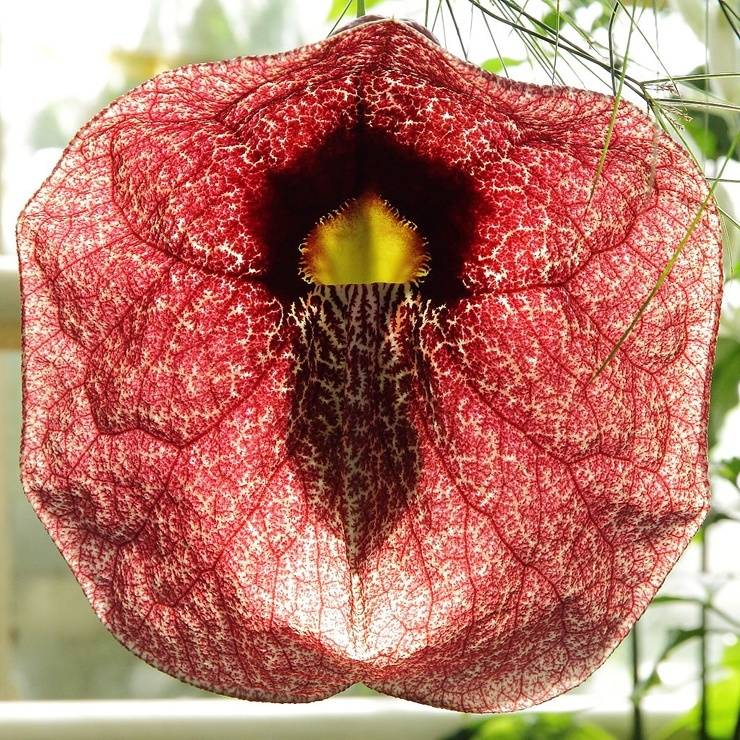

Aristolochia gigantea is a smelly plant native to South America: Panama, Brazil, possibly Colombia. Its characteristic red flower emits a pungent, fetid odor familiar to all waste handlers, which attracts bees and other insects, making it easier to pollinate. Often grown in greenhouses and botanical gardens.
9
Alyssum fragrant
Alyssum is grown in gardens, balconies and terraces as an annual ornamental plant with a strong aroma. It can also be used in special plantings as a honey plant - the flowers emit a strong delicate honey aroma, attracting bees.
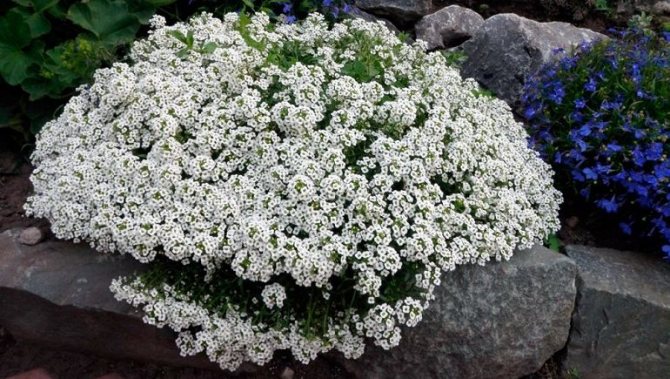

The culture gained deserved popularity for the decorative appearance of a low bush and an original small spherical inflorescence.
Interesting Facts:
- white flowers smell stronger;
- flowers of any type of alyssum after pollination become larger and attract insects to neighboring bushes that are just preparing to bloom.
Arisema three-leafed
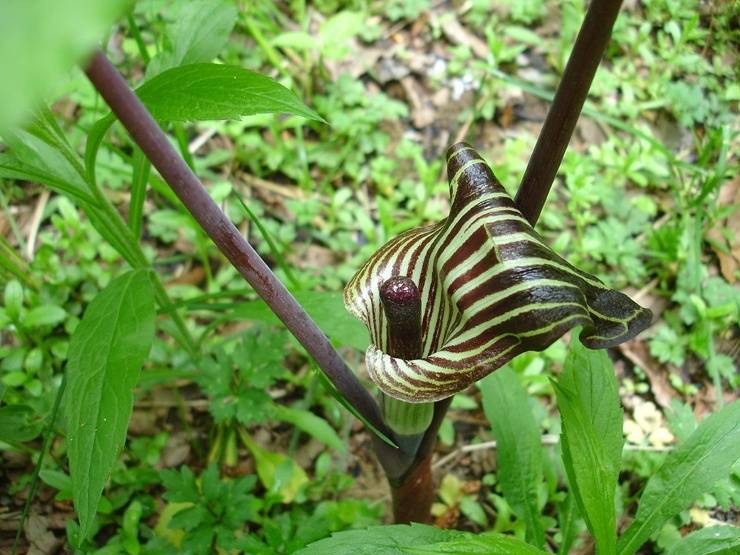

Three-leaved arizema is a herbaceous perennial plant that grows in moist forests, shrubs, and swamps in eastern North America. Typically it grows up to 30–65 centimeters in height. All parts of arizema trefoil are poisonous and contain calcium oxalate crystals, which in humans can cause severe pain, burning on the lips, mouth and throat, as well as profuse salivation, in rare cases, swelling.
7
Scented garden flowers and types of fragrances
All the variety of floral fragrances are usually divided into certain categories, based on their saturation and the nature of the main notes. Science has proven that pleasant smells evoke positive associations in a person, contributing to relaxation or, conversely, the appearance of a feeling of cheerfulness and a surge of strength.
Among the main varieties of aromas of famous flowers and plants, the following can be distinguished, namely, such as:
- - fruit - magnolia, geranium, some types of bearded irises;
- - pink - peony, rose, certain varieties of honeysuckle;
- - citrus fruits - lemon mint, lemon verbena, monarda, Chinese lemongrass;
- - honey - heliotrope, alissum, heather, barberry, musk rose;
- - spicy - cloves, fennel, nasturtium, some varieties of marigolds;
- - sweet - heliotrope, tuberose, honeysuckle, buddleya, clover;
- - heavy - lily, bird cherry, jasmine;
- - delicate - mint, lavender, rosemary.
Experimenting with different types of these and many other plants, you can create an extraordinary atmosphere on your site, woven from aromas of different shades. However, one should remember about the peculiarities of the fragrance of some garden dwellers and their effect on the human body - for example, that matthiola two-horned and scented tobacco intensify their aroma with the onset of dusk,and the rich, thick aromas of bird cherry, hyacinths, lilacs, white lilies and daffodils can provoke dizziness and even cause headaches.
Lizichiton American
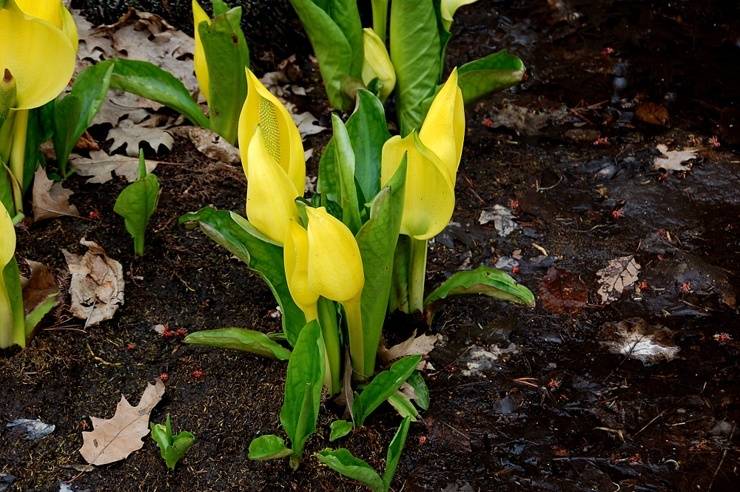

Lysichiton American is a perennial plant that grows in swamps and wet forests along streams, rivers and other places with high humidity in the west of the Pacific coast of North America. They grow up to 30-40 cm in height. It is one of the first spring flowers to appear mainly at the end of winter. They are often used in landscape design.
5
Symplocarpus smelly (Symplocarpus foetidus)
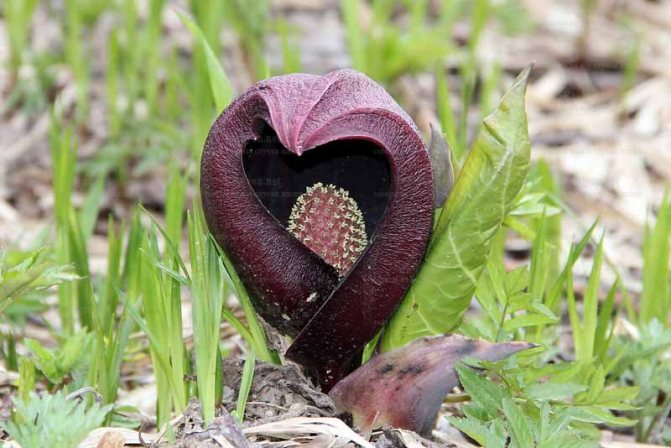

Habitat: China, Japan, North America and Russia - in the Far East. Prefers wet and damp places, flooded meadows, river banks and swamps.
The appearance of the symlocarpus is very exotic, especially against the background of barely melted snow. It is a burgundy, dense and leathery hood with a pointed end that hangs over a round yellow ear. It is characterized by a pungent odor, which can be described as carrion with garlic, so attractive to pollinating insects.
Dracunculus common
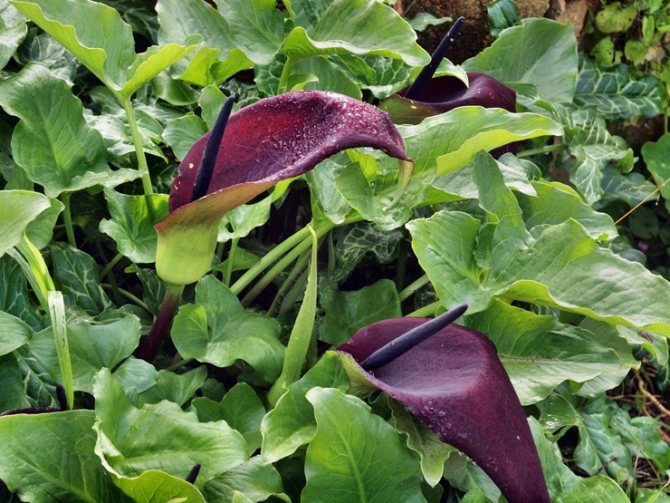

The fifth line among flowers with the most unpleasant odor in the world is occupied by the common Drakunculus. It is a perennial herb that is widespread in southern Europe - Bulgaria, Greece, Albania, Italy, France and Turkey. Able to grow up to 2 meters in height. The species is characterized by a large purple inflorescence 25–135 cm long, with an unpleasant odor reminiscent of excrement and carrion.
4
Sterculia
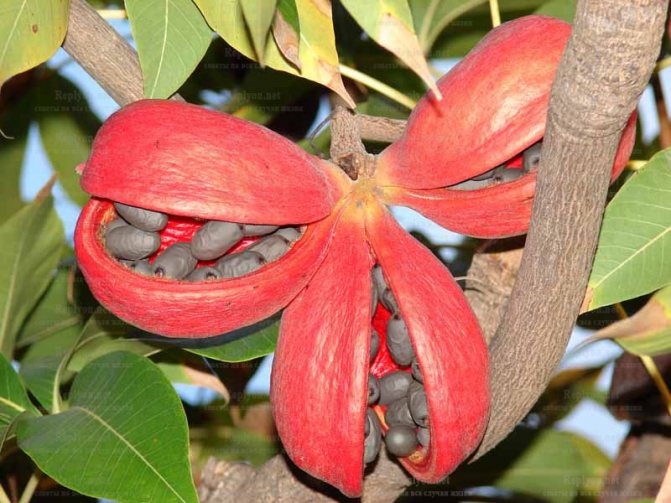

The smelly flower of this plant exudes such an unpleasant odor that among the ancient Romans he was the god of manure, and the name of a whole species of plants with an unpleasant smell is dedicated to him. Stinky Sterculia (Sterculia foetida) blooms only in its natural environment, spreading the smell of excrement. First, flowers appear, attracted by the smell of pollinators, and only then leaves appear.
Hydnora africana
Hydnora africana is a parasitic plant native to southern Africa. It leads an underground lifestyle and feeds at the expense of others, its roots go deep underground, where they stick to the roots of other plants, extracting nutrients from them. It has a fleshy orange flower, reaching 10-15 cm in length, which emerges from the ground after rains. Despite the fetid smell, some animals (jackals, porcupines, etc.), as well as local residents, eat the seeds and fruits of the African Hydnora for food.
3
Infodays
Nature has endowed some plants with the beauty of flowers and inflorescences, others have not endowed with a spectacular "appearance", but gave them a wonderful smell.
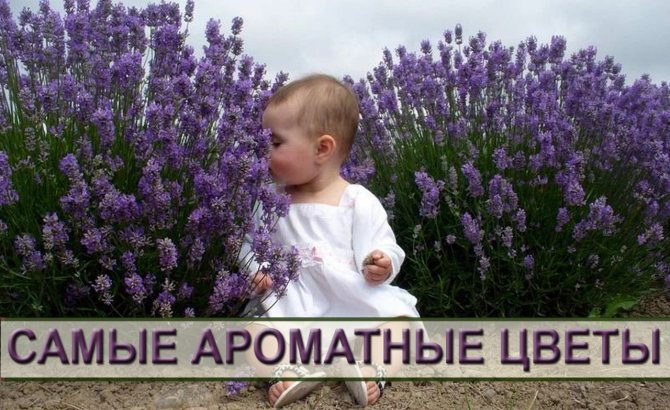

Today, both those and others are involved in the creation of fragrant flower beds. In the compositions, not only their beauty is manifested, but also a peculiar bouquet of aromas is created, which envelops the dacha with a light veil.
Some scents become our favorites, so from year to year we sow seeds and plant seedlings of plants with the aroma we like. Some varieties of fragrant flowers not only serve as decoration, but also have the ability to scare away harmful insects from garden and vegetable garden crops.
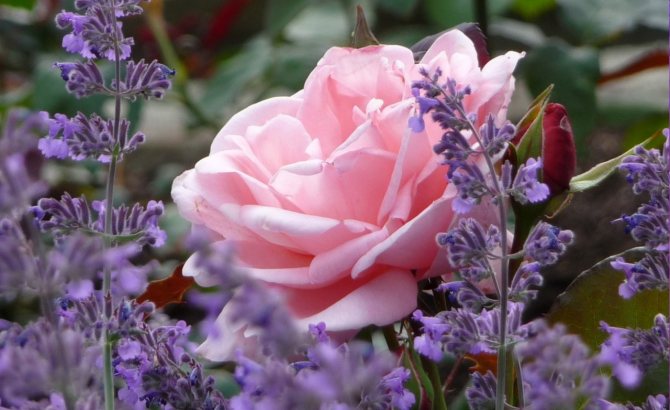

Carnation
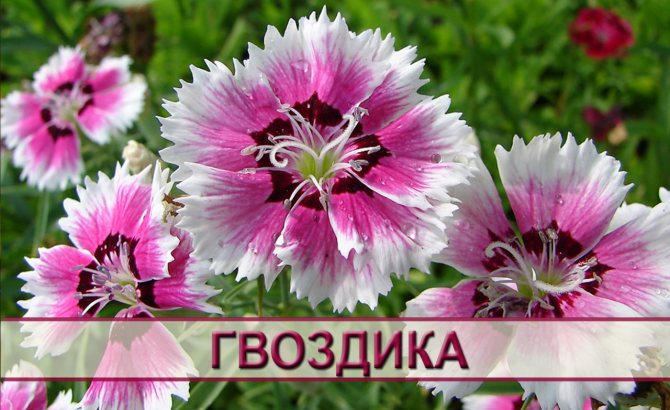

There are about 400 varieties of carnations, in a wide variety of colors and shades, including pink, white, red, or a mixture of pink and white. The unpretentious clove produces pleasant greenery that does not fade and remains fresh for quite some time. High varieties of cloves are mainly used for cutting. Carnations are both annual and perennial, and this fragrant flower is best planted in areas that are well lit by sunlight.
Gardenia
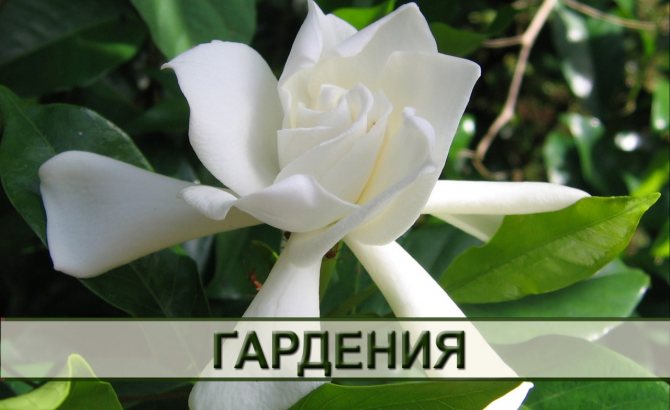

Every self-respecting fragrant garden should have in its assortment gardenia, an evergreen shrub with large white or yellow flowers.Another nice feature of the gardenia is that it is suitable for both the garden and indoor cultivation.
Ordinary tobacco
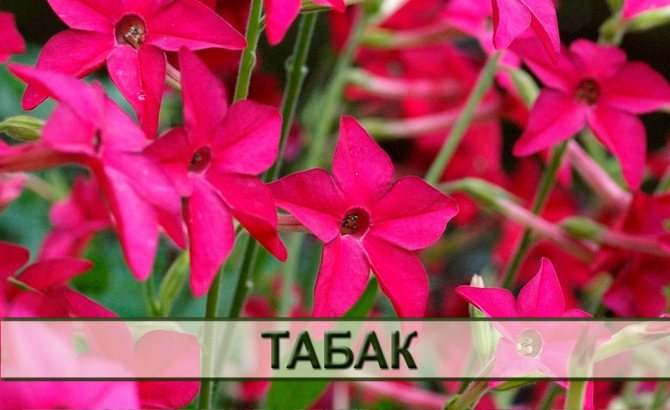

Possesses lush fresh greenery and beautiful pink and white flowers that fill the garden with a pronounced sweet scent. The flowers of the plant bloom in the evening, so it is best to plant the tobacco closer to the terrace or bedroom window, as the smell of flowers is most felt at night.
Autumn clematis
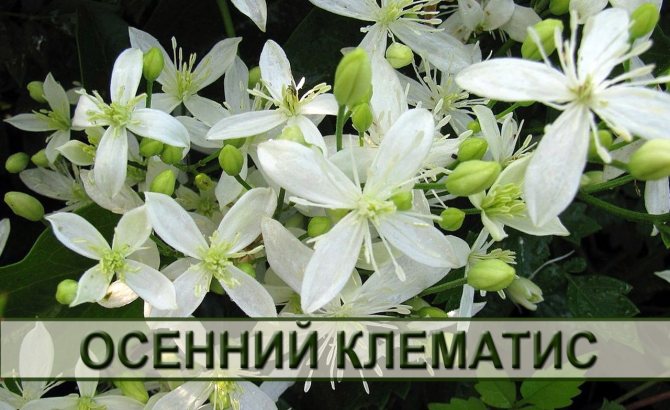

Thinking about how to decorate the garden in the fall? Try planting autumn clematis, which is a large vine, literally strewn with lovely white fragrant flowers (the length of the vine reaches 7.5 meters). Clematis prefers fertile soil, needs regular watering and bright sunlight. When planting autumn clematis, it is preferable to choose a place so that the root of the plant is in the shade, and the vine itself is on a well-lit sunny side.
Oriental lily
A delicate and refined lily can rightfully bear the title, the most fragrant flower, capable of filling the entire garden and its surroundings with its fragrance. Oriental lilies bloom in mid-summer and bloom until September. The most beautiful lilies are white, pink and yellow. Great as cut flowers.
Garden phlox
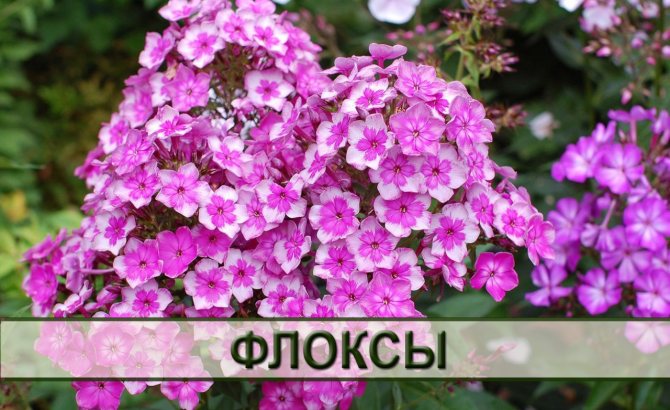

Perennial phlox, are compact lush bushes, covered with small beautiful flowers of white, pink, scarlet, lilac and blue. Phlox bloom towards the end of the summer season. The delicate sweetish scent of phlox is most clearly felt on warm sunny days.
Garden rose
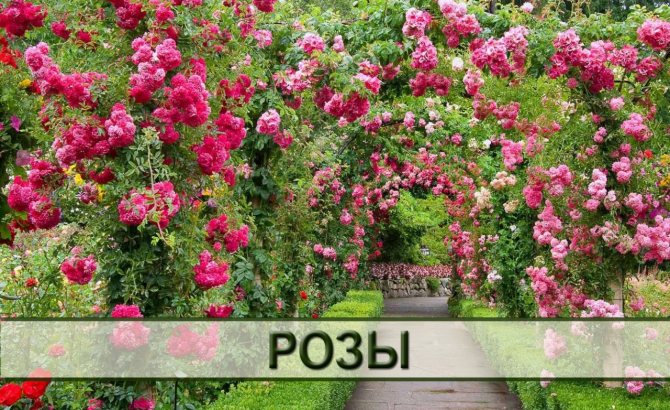

Almost every gardener has beautiful and noble roses in his assortment. Roses are presented in many colors and shades, ranging from dark cherry, almost black, to snow-white. Roses are very popular with flower growers.
Different varieties of roses differ not only in their colors, but also in the variety of aromas - there are roses with a floral or fruity scent, in the aroma of other varieties there are musky and citrus notes.
Sweet pea
Sweet peas got their name for a reason, distinguished by a bright persistent aroma. It is a climbing plant with small delicate flowers of various shades, some types of peas have a two-tone color.
However, if fragrant flowers for the garden are your goal, then you should be aware that some varieties of peas are practically odorless.
May lily of the valley
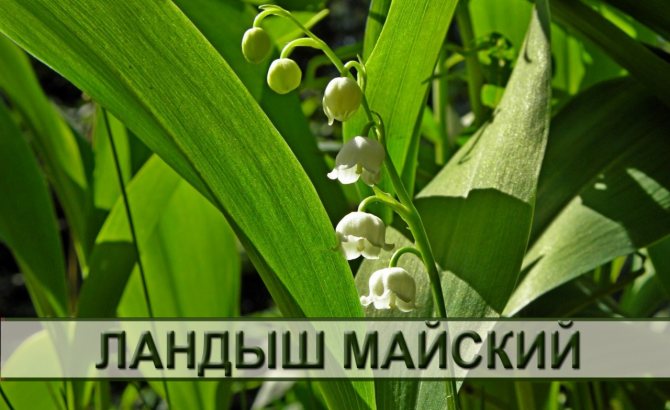

Despite the fact that it is very modest in size, this does not in any way affect the severity and intensity of the aroma that its white or pink bells emit. Lilies of the valley are extremely easy to care for, all you need is to plant flowers somewhere in a shady corner of the garden.
Hyacinth
Hyacinths prefer the sunny side or partial shade, and grow beautifully sheltered from the wind by other garden dwellers. These are early spring flowers. While all other plants are just getting ready to bloom, hyacinth is already filling the air with a delicious delicate scent. Hyacinths are planted in autumn, in a sandy fertile soil with good water permeability.
Iris
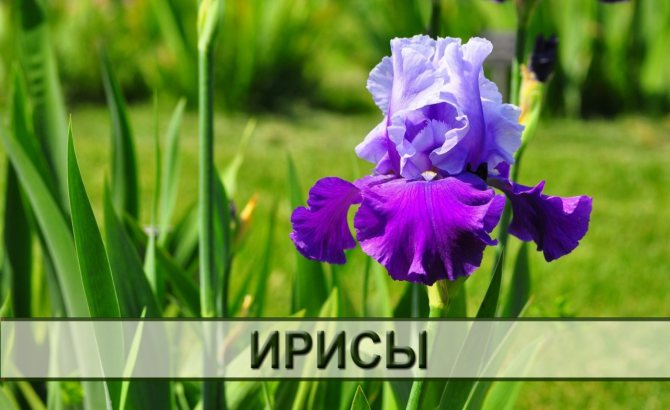

Irises, represented by almost all the colors of the rainbow, add color and life to any garden. They differ in a variety of aromas. The scent of irises can contain fruity and floral notes, as well as anise.
Common lilac
Lilac is one of the most widespread garden plants, flowering in early spring. Lilac is distinguished by its unpretentiousness to growing conditions, but, at the same time, it does not like shade very much. The plant is a luxurious shrub covered with fragrant inflorescences of white, lilac and purple flowers.
Heliotrope
When heliotrope blooms in the garden, invite your friends over and ask them what the scent of its flowers reminds them of.Opinions vary as to whether heliotrope smells like grapes, vanilla, cinnamon or cherry pie. Although it doesn't matter, the main thing is that you will definitely love the pleasant smell that the lovely purple, blue or white flowers of this plant give off.
Lavender
Lavender is a perennial herb that is an evergreen shrub or subshrub. Since ancient times it has been famous for its aromatic properties. Grows best on the sunny side and prefers soils with good water permeability. Lavender flowers emit a light and delicate scent with a refreshing floral note.
Lobularia seaside
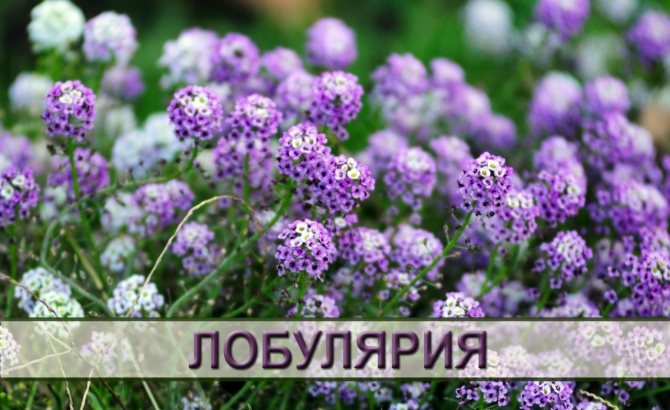

Seaside lobularia is an annual groundcover, which is a carpet of white, pink, lilac or purple flowers. It rarely grows more than 15 cm in height and is therefore an excellent addition as a cover plant for flower beds, rock gardens, hanging planters and outdoor flower boxes.
Pion
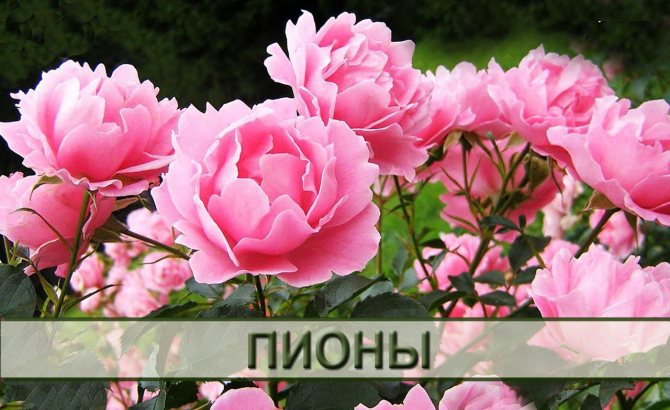

It is a well-known unpretentious plant that does not require much maintenance. A great option for cutting flowers. It should be remembered that not every variety of peonies belongs to fragrant flowers; before buying seeds, you should read about the characteristics of different varieties.
Moonflower or morning glory - lunar vine
An annual fragrant flower is best suited for an evening garden, as the scent of its large snow-white flowers, resembling pipes, tends to increase with sunset. Well suited for regions with hot and sunny weather, does not require much maintenance.
Southern magnolia
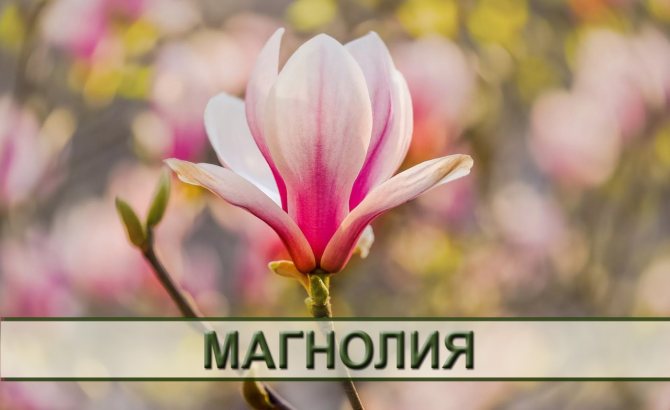

If your goal is to find the most fragrant flowers for your garden, then southern magnolia cannot be ignored, a plant that has a very strong aroma and beautiful creamy white flowers that bloom in spring. Magnolia is a tall tree 18-20 meters tall with shiny evergreen foliage and red fruits in autumn. There are also shrub varieties of magnolia of a more modest size.
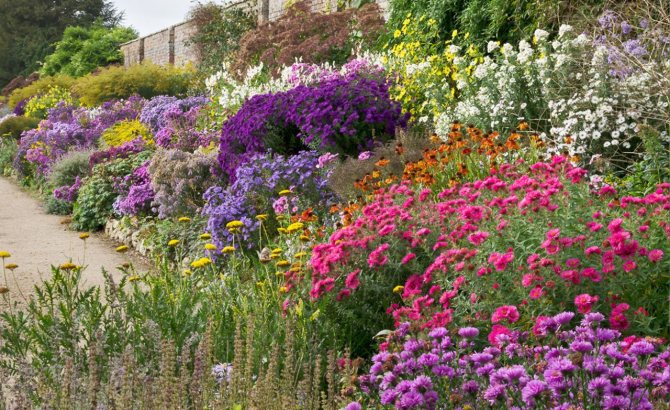

A single plant (even with a very rich aroma) rarely gives the desired effect, so gardeners resort to creating various compositions in fragrant flower beds.
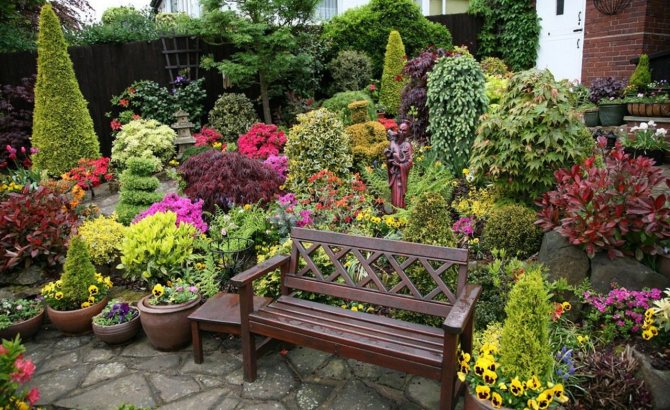

All this, of course, will take some time and require some knowledge and effort, but you will certainly be rewarded with the enchanting fragrance of your unique fragrant composition, created taking into account your preferences.
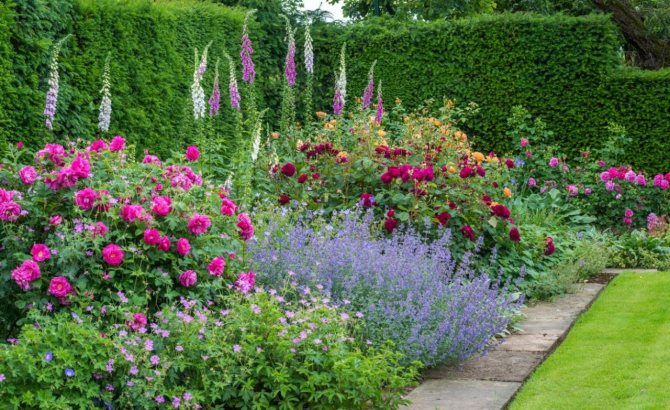

Post Views: 6
18.03.2018
- The parable of family understanding
- List of items lost in space
Rafflesia Arnold
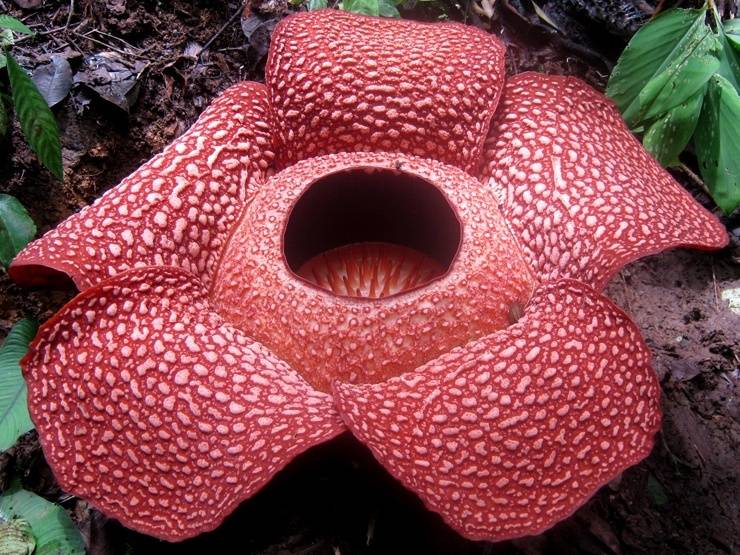

Arnold's Rafflesia is a parasitic smelly plant native to the rainforests of the Indonesian islands of Sumatra and Borneo. This rather unusual and rare plant is considered one of the largest on the planet. The diameter of its flower reaches more than 1 meter, its weight is up to 8 kg. Rafflesia Arnold does not have a pronounced stem, leaves and even roots; it receives all the nutrients from the host's body. Due to the specific smell emitted, similar to the smell of rotting meat, it is often called "cadaveric lily".
2
Devil's fingers (Clathrus archeri)
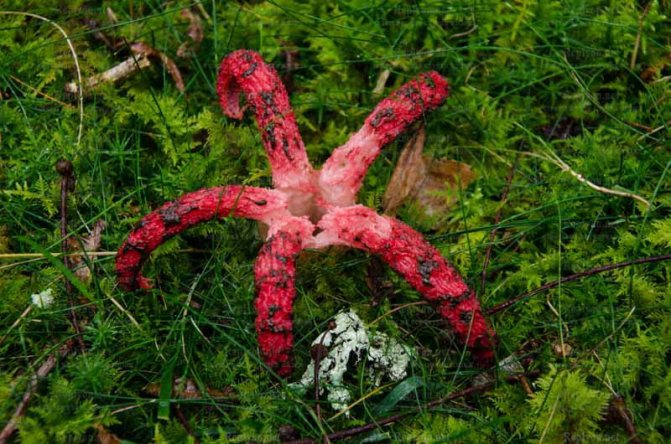

This is a mushroom that would be suitable as a backdrop for an alien movie. Before the lobes open, it looks like a large egg with a non-uniform tuberous surface, off-white in color with brown and pink spots at the base. Later, when its blades (3-8 pcs.) Open, it takes the form of a red star-shaped flower, the petals of which look like slippery tentacles. Inside, the plant is spongy, lumpy, covered with brown mucus. It emits a cadaveric smell that attracts insects that spread its spores.
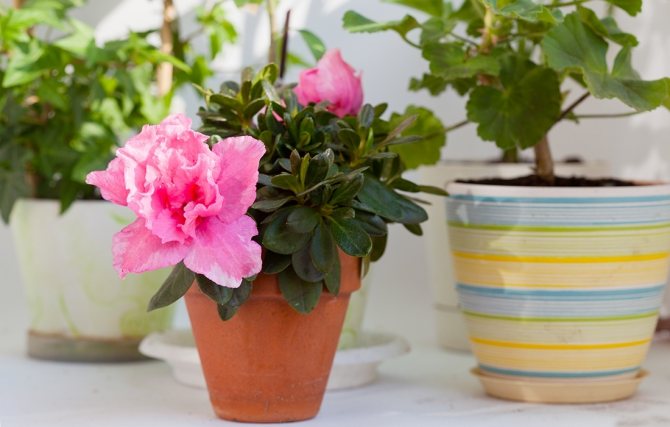

Among the best indoor plants, we would like to highlight for you the most fragrant ones, which will improve the microclimate in the house and cheer you up. They are great for your health! Simply by inhaling their scent, you clear your lungs, so it becomes easier for you to breathe, as after walking in the woods.Let's see what are the best indoor plants!
Amorphophallus titanic
Amorphophallus titanic is a large plant that until recently grew exclusively in the tropical forests of the Indonesian island of Sumatra, but with the arrival of man here it practically disappeared. Now this unusual plant is cultivated in greenhouse conditions in botanical gardens around the world. Able to grow up to 3 meters in height. During flowering, which lasts 1–2 days, the flower depletes a fetid odor reminiscent of a mixture of rotten eggs and rotten fish.
1
Rafflesia arnoldii, (Rafflesia arnoldii) or Corpse flower
The beauty reaches a meter in height and 10-12 kg in weight. It is the largest single smelly flower. This plant with blood-red petals, as if covered with a whitish mold, can be found in the tropics of Sumatra, Borneo, Indonesia, the Philippines and Malaysia. Rafflesia is a parasite, they attach to the donor through filamentous fibers, drawing out all the liquid and trace elements from it. Leaves and roots are absent, so it does not carry out photosynthesis. It takes about 2-3 years to bloom, all this time it represents only threads growing inside the parasitized plant. After that, a small embryo is formed, which eventually reaches gigantic proportions, and looks (and smells) frightening. The smell of rotting flesh attracts flies, which pollinate it. Flowering lasts only 3-4 days.
Giants are record holders. 10 largest vegetables and fruits in history
More than once, gardeners have found in their garden fruits of a bizarre shape or especially large sizes. But could you imagine that cabbage will sprout up on your garden bed as big as an adult or ...
October 10, 2019, 17:10
Always smell
Myrtle
This evergreen plant will be a real freshener for your home! And the leaves and stems of myrtle spread a fresh scent around.
Araucaria
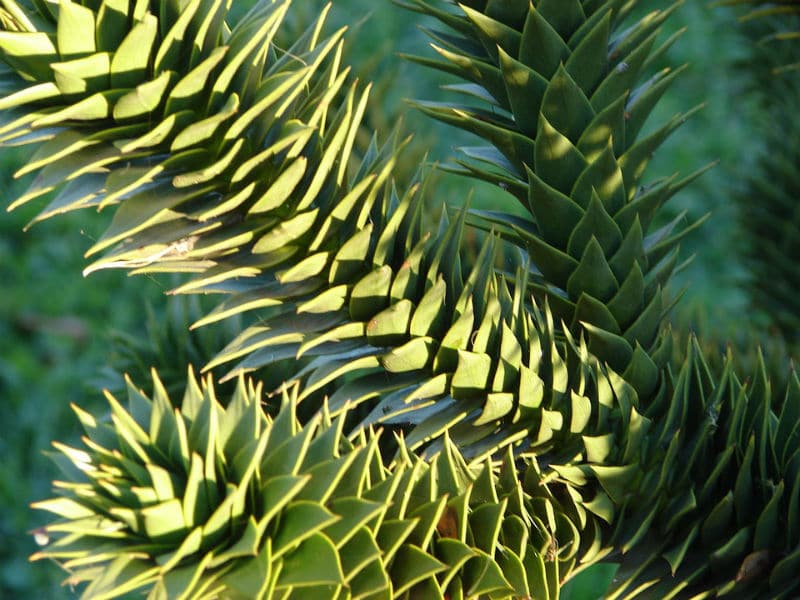

Photo:
This plant fills the air with phytoncides, filling the space of the house with a soft coniferous aroma. It is easy enough to grow in the house.
Beautiful flowers with an unpleasant smell
The world of flowers, varied and multifaceted, is most often associated with beautiful, pleasantly scented flowers. But not everything is so simple in the world of plants - among the flowering crops there are those whose appearance does not fit in any way with the fetid odor they emit.
A flower that smells so that you want to leave and not hear this smell cannot look beautiful and original, but, nevertheless, it is so - beauty is combined with an unpleasant impossible smell.
Stapelia
In appearance, the succulent plant with juicy and fleshy shoots resembles a cactus, and the flowers, covered with villi and spots, look like a five-pointed star. Despite its visual appeal, a beautiful bright flower smells like rotting flesh.
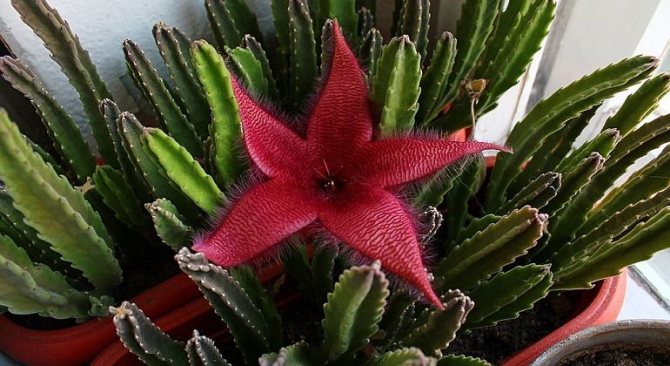

The heat-loving flower is native to South Africa and grows where flies are the only pollinators. This explains the unpleasant smell - flies are attracted only by such a specific "aroma".
Attention! When growing a slipway, you should be prepared for the fact that during flowering you will need to either come to terms with the smell, or move the flower pot away from the most visited places.
Lizichiton
Lizichiton belongs to wetland plants and has been growing in one place for more than one year. The flower is so called because of the presence of a "cover" around the inflorescence, reminiscent of a calla. The cover gradually collapses as the fruit ripens. An unusual plant can be found in Alaska, in the Far Eastern regions, in the western regions of the United States.
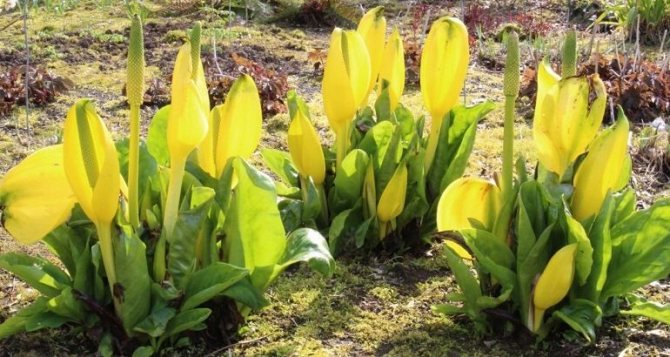

The popular name of lisichiton is "marsh skunk". This is due to the fact that beautiful lemon-yellow or white flowers smell like fetid stagnant swamp mud. The smell is not associated with a beautiful delicate flower, but Nature arranged it this way to attract pollinators.
Interesting facts about lysichiton:
- blooms very early - in April;
- the flower emits heat that can melt the snow next to the snow - this allows the plant to survive in cold weather;
- perfect for decorating ponds, low areas with stagnant water;
- in ancient times it was in circulation as a plant with medicinal properties.
Nature has made it possible for man to enjoy the beautiful in its various manifestations - very beautiful flowers with a wonderful enchanting aroma and no less beautiful, but disgusting-smelling plants. But, nevertheless, the amazing world of plants adds beauty and positive to our life, forcing us to sometimes think about, and about what - everyone will have their own reason for this.
Top 10 most fragrant flowers
Ecology of consumption. There are beautiful flowers. And there are fragrant ones. As a rule, these two properties are rarely combined in one flower. Even in roses, the smell is not as intense as, for example, in a discreet mignonette.
There are beautiful flowers. And there are fragrant ones. As a rule, these two properties are rarely combined in one flower. Even in roses, the smell is not as intense as, for example, in a discreet mignonette. Russian front gardens were famous for fragrant flowers. What are they? Mignonette
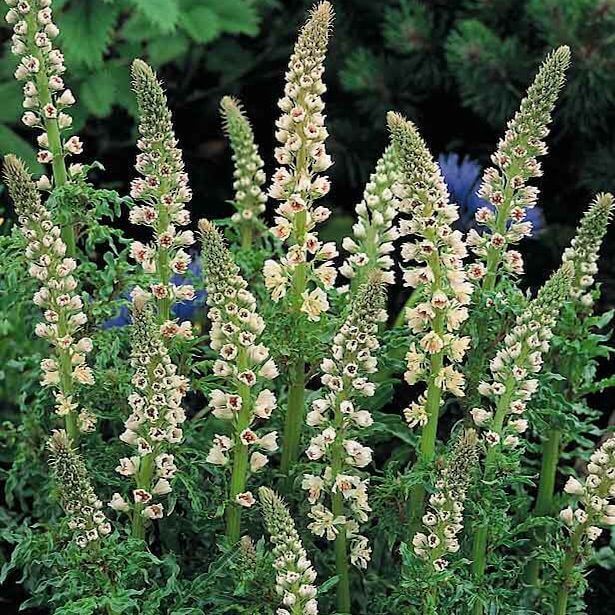

In the evening, mignonette exudes a wonderful aroma. Mignonette is not famous for its flowers, so you can plant it among representative handsome men. It blooms for a long time - from mid-summer to frost. The most fragrant and oldest variety is fragrant mignonette. Not demanding on the soil. Loves the sun. Plant height from 20 to 40 centimeters (depending on conditions and variety). Heliotrope
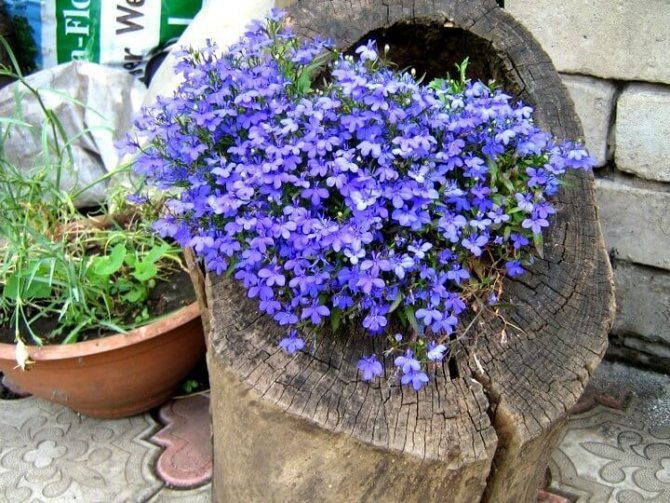

Heliotrope is good for both smell and color. Blooms until frost. There are tall varieties that are grown in large pots in greenhouses. Heliotrope is beautifully cuttings. Therefore, at the end of summer, you can do the "supplies" for the next spring. Rooted cuttings are stored in a warm, bright room. In the garden, the heliotrope prefers a sunny place. Monarda
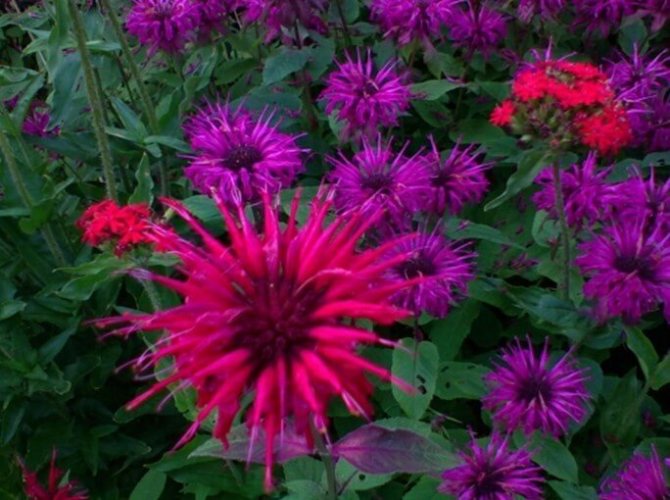

Monarda smells really strong - mint. The smell is not so much in the flowers as in the leaves. The flower is unusual: one-, two- and even three-story. A short stem grows from the middle of the flower, on which another flower blooms. Monarda flowers are white, pink, red. Bloom in July-August. Monarda is a perennial. You can propagate it by dividing the rhizomes. Demanding to watering. Mattiola (levkoy)
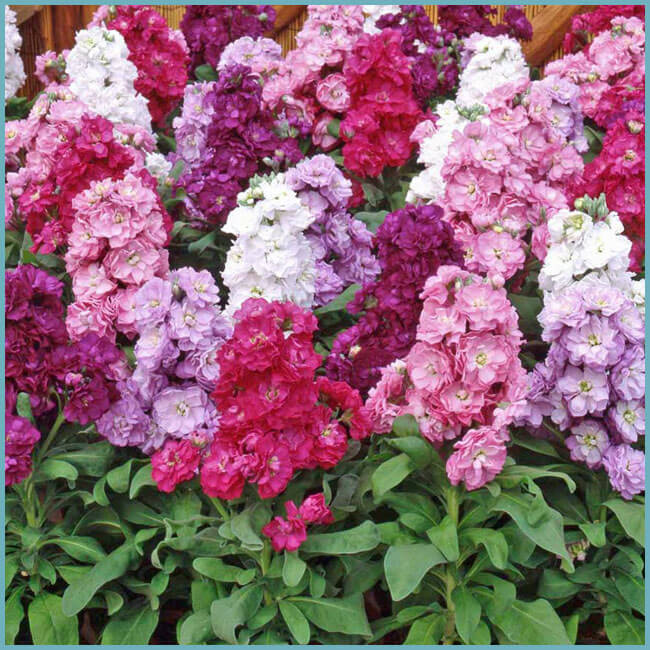

People call Mattiola two-horned "night beauty". There are many varieties of Levkoy. There are small, nondescript ones, and there are luxurious, high peduncles. There are early flowering (first half of summer) and late flowering. Some varieties look great when cut. Levkoy is also good in that it is represented by the widest palette of colors. Annual (except for the "night beauty"). Each season is grown through seedlings. Sweet pea
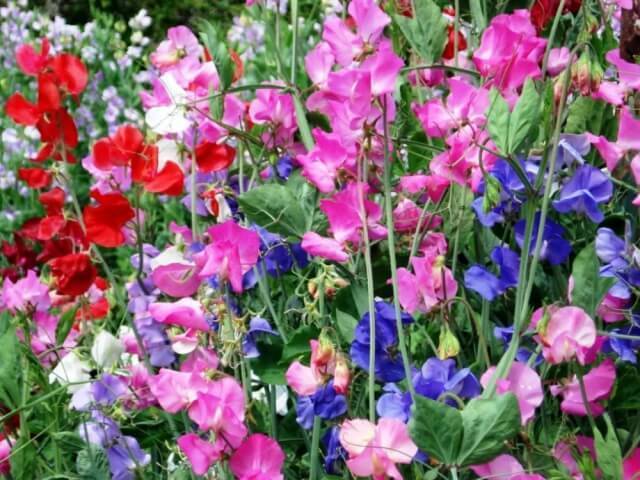

Sweet peas have become very popular lately. In order for the pea bush to grow luxurious, you need to prepare in advance "fat", rich soil. When the young stalk reaches 10-15 centimeters, the crown is pinched, after which it gives many lateral shoots. Support is required. The height of most varieties of peas reaches 2 - 3 meters. For abundant flowering, withered flowers are regularly removed. Loves the sun and watering. Scented tobacco
Under good conditions, tobacco leaves grow large and beautiful. The flowers are delicate and very fragrant. Scented tobacco should be planted in a group, this enhances the aroma. Shades are different: light, pink, burgundy, greenish. There are undersized varieties, but most varieties reach 80-100 centimeters. Blooms from mid-summer to October. Marigolds are thin-leaved
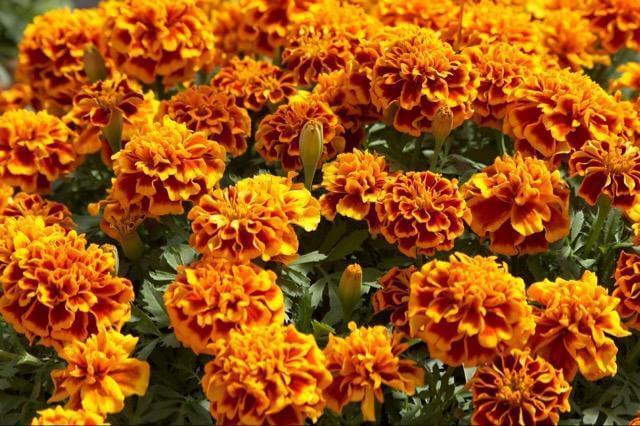

Marigolds are a very popular annual. Not picky about the soil. Blooms until frost. Meadowsweet
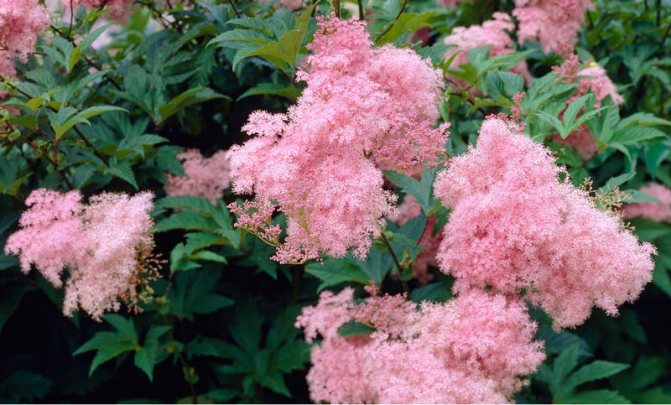

In the wild, we can meet meadowsweet at the edges of the forest. Foliage is attractive: finger-like or feathery, slightly rough (like raspberries). Numerous white flowers are collected in long and fluffy paniculate inflorescences. They smell like honey, which is what attracts bees. The meadowsweet is unpretentious.Several cultivars have been bred, which is why the "caps" of flowers have become more magnificent, colored in pinkish and yellowish tones. In the cut, the meadowsweet fades quickly. Blooms for about a month. Prefers light shade. Phlox
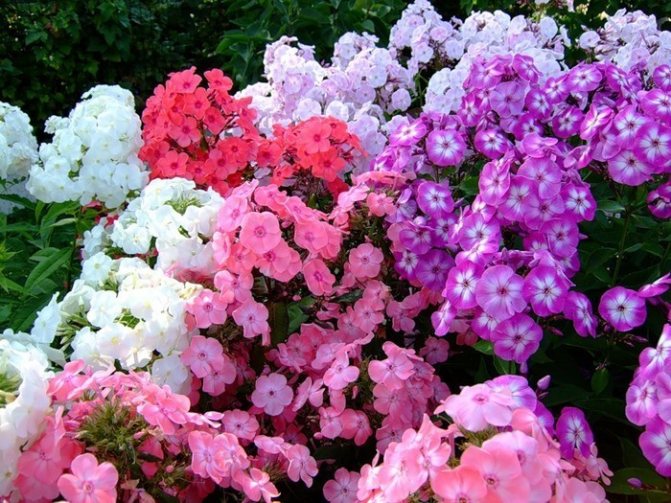

Phlox is a luxurious and beloved perennial. Decorates the garden from mid-summer to late autumn. In autumn, the stems of a faded phlox bush are cut off, leaving a small "stump". To prevent the root from exposing in spring, phloxes mulch (sprinkle a little with earth, peat and sand). In hot summer, watering is required. Phlox reproduces by spring or autumn root division. Cuttings well in spring. Pion
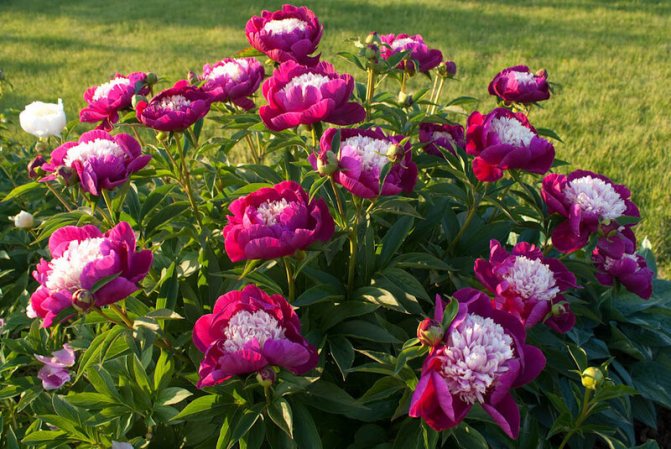

The beauty and pride of Russian gardens. Simple, double, semi-double, anemone - everything is beautiful and fragrant. Planted in the fall. Peonies prefer light shade. They do not like stagnation of moisture in the soil. published by
Jasmine (Jasminum)
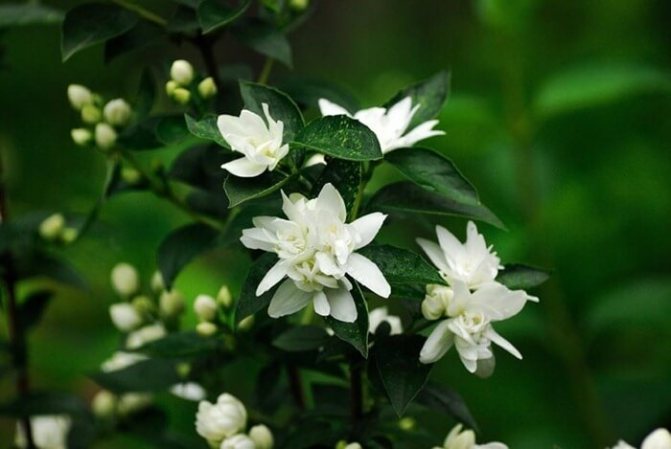

In second place in the top 10 most fragrant flowers is the sweet-smelling white jasmine. This is a flower of the tropics, but its scent is well known to Russian women. After all, jasmine is used to make a variety of beauty products, from shampoos and hand creams to perfumes and face masks.
Jasmine flowers are the source of one of the most pleasant and popular fragrances in the world. However, they are also used in cooking, imparting a unique smell to tea and desserts, as well as in folk medicine, for example, for skin diseases and as an antidepressant.
Gardenia


This genus of tropical plants was named after the famous Scottish botanist Alexander Garden. Gardenia flowers are a frequent decoration for weddings, as they have an important religious significance, and retain their beauty and fragrance for a long time, reminiscent of the scent of jasmine. Gardenia white symbolizes purity and innocence, and perfectly complements the bride's dress.
In large quantities, the intoxicating scent of gardenias can overwhelm all other odors in the garden. These scent beauties are capricious in grooming and susceptible to aphids and powdery mildew.
Fragrant flowering perennials in the garden
Perennial flowering plants with a pleasant aroma are good because after planting in the garden they will delight the owner and his guests for several years not only with the brightness of the flowers, but also with the aroma. Such plants include:
- pion
- alissum
- reddish clover
- lily
- honeysuckle honeysuckle
- lilies of the valley
- chrysanthemums
- lush carnation
Alyssum or beetroot - a garden flower from the Cabbage family, has many decorative varieties, most often undersized or ground cover, from 10 to 30 cm in height, shoots branch well, flowers are small, collected in inflorescences - umbrellas, medium-sized leaves, grayish-green, color of flowers white, light yellow.
The plant is unpretentious, grown from seeds by sowing before winter or spring, attracts flower lovers with a well-pronounced smell of honey, is suitable for decorating garden paths, flower beds, is used as a ground cover plant that covers the ground with a snow-white fragrant carpet.
Red or reddish clover is a plant from the legume family, in the shape of an inflorescence little similar to pink clover or meadow clover, inflorescences are large, elongated - ovoid, up to 10 cm long, collected from small narrow flowers, flowering time June - September, have a pleasant smell, a bit like the smell of roses or wild rose hips.
Can be grown in partial shade, propagated by seed or dividing the bush, suitable for natural garden corners. Peonies are perennial rhizomatous plants, the ground part dies off annually, and in the spring the growth of new shoots begins, propagates by the root, is planted before winter, the plant has many varieties, the flowers are large, fragrant, the smell is pleasant, sweet, the flowers are almost always single, can be double, simple , semi-double, flowering time from the end of May - June.
Fragrant flowers for the garden on video:
Lush carnation is a perennial frost-resistant plant, has creeping rhizomes, thin long stems, large fragrant flowers of pink or lilac color, when grown in a garden is unpretentious, can become an adornment of rocky gardens and hills, has several varieties.
Bulbophyllum phalaenopsis
The plant Bulbophyllum phalaenopsis is believed to have the most unpleasant odor. This original flower is one of the varieties of orchids. The birthplace of the plant is New Guinea. This flower, despite a rather unpleasant smell, reminiscent of rotting meat, is often grown at home as a houseplant.
Although many people associate flowers with a pleasant fragrance and beauty, as we can see, there are a huge number of plants in the world that have a delightful appearance, but exude a repulsive unpleasant odor. All this is created by omnipotent nature for an easier way to attract pollinators to flowers.
The aroma of exotic flowers is present in the home of an amateur florist almost throughout the year.
Today, many varieties of tropical plants have been adapted for home cultivation, and most of them, when flowering, emit a delicate peculiar aroma. Of course, among indoor flowers, you can find varieties with little or no aroma. However, it is these plants that are recommended for landscaping public places and office premises. This is due to the fact that some people suffer from allergic reactions to certain, including floral, odors.
Most indoor, ornamental plants can be roughly divided into two main categories
:
- plants in which only flowers emit fragrance;
- the smell comes from the whole plant, and it is especially intensified when its vegetative part is damaged.
The first group includes most orchids, roses, gardenias, and some types of cacti.
However, it is possible to find orchid hybrids that do not emit any odor when blooming.
Orchid Cattleya aclandiae.
One of the pleasant-smelling orchids is the orchid
Cattleya aclandiae
, flowers that smell like lily of the valley.
Hymennokalis.
The aroma is simply charming! Hymenocallis flowers have a large stem with fragrant snow-white flowers with tall, spider-like, pale yellow calyx-shaped petals and large, quivering stamens. Flowers can appear both in late summer and early autumn. One inflorescence can have from six to eight shiny white flowers up to 20 centimeters in length.
Madagascar Jasmine - Stephanotis Thou
is a semi-shrub vine that develops well and blooms only in good light. Therefore, it is grown on windowsills on the south side of the dwelling. The star-shaped small flowers have a sophisticated, sophisticated aroma.
Gardenia
, especially one of its subspecies -
jasmine gardenia "Gardenia jasminoides"
when blooming, it exudes a powerful, sophisticated aroma. However, in home culture, this is a rather capricious plant. Despite the fact that most gardenia species are photophilous, when grown indoors, the plant does not tolerate direct sunlight.
Amazon lily - Eucharis (Eucharis Planch)
has white, daffodil-like flowers with a delicate, pleasant scent. The plant is perennial, and under good growing conditions it can bloom all year round, periodically throwing out umbrellas on which 5 ... 6 single flowers bloom.
Wax ivy - Hoya
includes several subspecies, which are quite common in indoor cultivation. The plant belongs to ornamental lianas, and exudes a sweetish smell during flowering. The plant does not require painstaking care and increased attention, but its flowering begins only at a "mature" age.
Murraya paniculata - orange jasmine (Murraya paniculata)
, has not yet become widespread in home floriculture and professionals are engaged in its cultivation. They form a dwarf tree from a bush, with year-round flowering. The white flowers of murraya have petals, as if doused with wax. When blooming, the odor emitted by the plant has a subtle, pleasant aroma.
Bouvardia long-flowered.
Shrub with oblong leaves and numerous flowers, collected at the ends of annual shoots. The corolla tube is up to 10 cm long. The aroma of white flowers is reminiscent of jasmine.
Pittosporum odorous or Smolosemyannik ordinary
... A tree with decorative dense leaves and small, up to 1 cm in diameter, flowers, collected in corymbose inflorescences
.
Freshly blossomed flowers are white, then they become ivory. As a result, in one inflorescence, flowers differ somewhat in color. Mild, vanilla aroma.
Rafiolepis umbrella.
A tree with leathery dark green leaves and beautiful flowers, collected in inflorescences at the tops of the shoots. The flowers give off a soft, sweet aroma.
Sarcococcus is low.
Evergreen shrub with leathery evergreen leaves and clusters of small flowers with long stamens blooming in their axils, in the place of which maroon spherical fruits later ripen. The flowers are white with yellowish stamens, emitting a strong spicy aroma, somewhat reminiscent of a melon.
Eriobotria Japanese or Japanese medlar.
A tree with tomentose-pubescent shoots and wrinkled large leaves, serrated along the edge. Small flowers are collected in 30 - 50 pieces at the ends of the shoots in paniculate inflorescences. Juicy small (up to 3 cm in diameter) rounded yellow fruits are very pleasant to the taste and ripen in June. The creamy flowers give off a sweet almond scent.
Abelia Chinese.
It blooms with a small cuttings, has a pleasant delicate aroma, somewhat reminiscent of the scent of a lemon flower. It is an ornamental flowering shrub that blooms for a long time and is very abundant. It is better to donate an adult plant in a large room.
Oleander Chinese.
Have
oleander
very fragrant flowers, long inhalation of their scent can cause headaches. The pink or white flowers of this evergreen shrub are very beautiful, the plant is quite unpretentious.
Sansevieria.
All varieties of this popular indoor phytogenet produce unusually long stalks that bloom in the evening and emit a pleasant and slimy aroma reminiscent of the scent of a lily. Sansevieria (sansevieria) blooms in spring and / or autumn. Each flower fades in the morning. However, there are many of them on the peduncle, so you can enjoy the fragrance for a long time.
Some varieties of indoor roses.
They have a bright and delicate aroma. It is believed to have a good effect on well-being and is a powerful aphrodisiac. The smell of these flowers can be heard wonderfully in a small room.
Selenicerus cactus.
Echinopsis cactus.
An example the second group of plants, the aroma of which comes from the entire vegetative part
, the well-known
pelargonium - geranium (Pelargonium)
,
The family includes about 400 species and subspecies. If the plant is not damaged, there is no smell from it. But it is worth rubbing the leaves of fragrant pelargonium (Pelargonium graveolens) between your fingers, the whole room will be filled with a steady, somewhat harsh odor.
Most citrus fruits (lemon, tangerine, orange)
in indoor culture they are formed in the form of small trees. All parts of the plant - leaves, stems, shoots - have a pleasant aroma.
Eucalyptus.
All varieties of this plant emit a fragrance. But the most striking of these indoor trees is lemon eucalyptus. With a small touch, even on one leaf, it is able to saturate a standard medium-sized room with aroma.
Plectrantus or indoor mint.
Plectrantus or indoor mint is valued for its ease of maintenance and decorative attractiveness of leaves with a pleasant mint aroma. Its flowers are small, lilac or white.Some species have a pungent odor and are used to repel moths.
Araucaria (Araucaria heterophylla and Araucaria bidwillii spp.)
one of the few conifers adapted for growing at home. A pleasant coniferous aroma emanates from the crown of the dwarf trees of araucaria Bidvilla and varifolia. Araucaria growing in a residential area saturate the air with natural phytoncides.
Common myrtle.
A low-growing tree, branches are densely covered with leathery, dark green aromatic leaves, in the axils of which there are single flowers. White flowers give off a sweetish, light aroma.
When growing aromatic plants at home, make sure that all family members are not allergic to specific odors. It is better not to keep flowers with a strong smell in the nursery and bedroom.
Do Kindly, SHARE this page on social media. networks
Good day everyone!
And again about fragrances and flowers. Smells play a huge role in the life of every person. According to the smell we remember, associations arise from the past, a certain holiday. Naturally, women want to create the smell of their home, to have a unique aroma of their home. In this, instead of artificial and not always harmless substances, pets - flowers - will come to the rescue.
Using different scented plants, you can create an individual scent design in your home, depending on the destination.
One of the first aromas from childhood is the smell of geranium, another name for the plant is fragrant pelargonium. They knew about its properties even in ancient times - traditionally geranium was in the bedroom, contributing to a sound and healthy sleep.
Each type of geranium has its own smells - it smells beautifully of a rose of Pelargonium capitate, the smell of lemon comes from Pelargonium curly, if you smell the Pelargonium felt, you can smell the mint, the fragrant Pelargonium smells comparable to the smell of nutmeg.
A valuable essential oil is obtained from geranium, which is widely used in the cosmetic and perfume industry. Aromatherapists also love him.
With the help of the aroma of geranium, you can heal sick people - it relieves depression, improves vision and increases optimism.
A characteristic feature of the plant is that it exudes aroma only when touched. Therefore, it is recommended for the bedroom - so that in the morning, when you wake up, you can easily touch it and feel your favorite smell.
Taking care of pelargonium is simple - you only need a sufficient amount of light, regular and abundant watering. You can buy young flowers or their seeds. They are. By the way, they sprout well and bloom very quickly.
See how many different varieties of geranium there are!
Pion
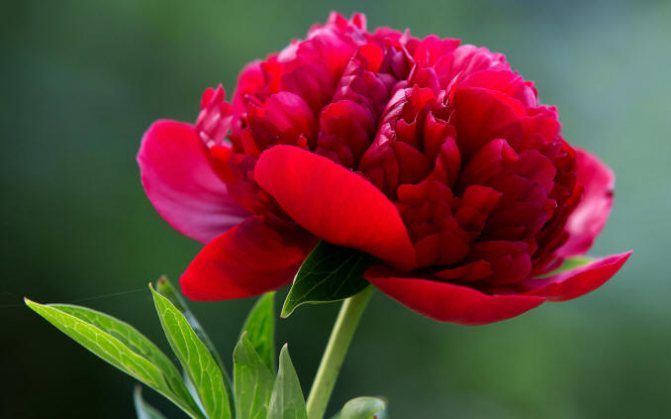

With their heady aroma, perennials peonies can seriously compete with a rose, of course, we are talking about their odorous varieties. Peonies bloom from late spring to late June, reaching the main peak of fragrance in the first half of the day. This flower loves the sun and good watering (without waterlogging). The aroma of peonies can be heard even from afar, this quality is inherent in the varieties "Edens Perfume" (reminiscent of the scent of Damask rose), "Mikado" (Japanese-type peony), "Cora Stubbs" (one of the most fragrant representatives), "Amalie Olson" (huge snow-white buds with a captivating aroma), “Myrtle Gentry” (large white-pink buds), “Vogue” (very beautiful, like pearlescent buds of white-cream and white-pink shades).
Black kosmeya
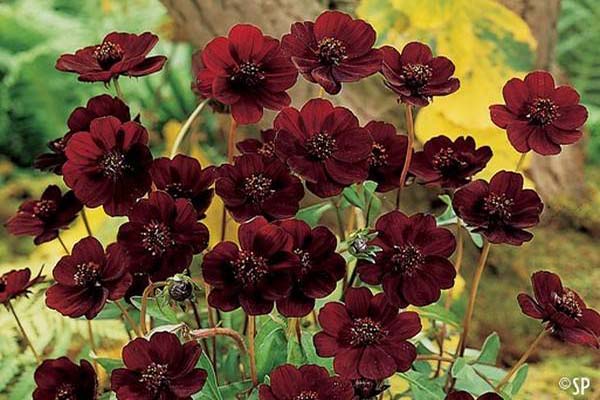

It grows in Mexico, and due to its unique color it was named chocolate cosmos. The flowers of the Black Cosmos are reddish-brown, and the persistent scent is associated with vanilla. And again, an innocent appearance is deceiving - the plant is poisonous, and the alluring smell just attracts insects. Moreover, the aroma intensifies along with the temperature: the hotter, the stronger the flower smells.
The aromas of appetite.
In the kitchen, the pleasant aroma of your favorite spices will be natural.Farther from the stove, on a windowsill or shelf against the opposite wall, you can install several pots of spicy herbs - it will fill the kitchen with a bouquet of aromas of your favorite tastes.
Savory, lemon balm, ptrushka, mint, and laurel are most commonly grown. Mint also helps to concentrate and relieves mental fatigue.
Lavender and laurel are perennial shrubs, they will be appropriate not only in the kitchen, but also perfect for the bedroom, because their phytoncides improve the air quality in the house.
You can also drive out other bulbous - tulips and daffodils, crocuses, lilies.
From indoor bulbs, eucharis will give a pleasant aroma, which blooms with beautiful white flowers, similar to daffodils, and some varieties.
Giant stapelia
This stunted plant is native to Africa (southeast of the continent). Its height is 20 cm, diameter is 35 cm. The smell of a flower, which attracts mainly flies, also resembles rotting meat.
This flower is also grown indoors. Yes, such a smelly house flower can be seen in the collections of many lovers. By the way, a plant with such original inflorescences is an unusual addition to the design of many interiors.
Stapelia is a succulent, like its hairy ones, it is usually brownish in color.
Fragrant flowers for the garden
Plants and flowers with a pronounced pleasant smell not only delight our sense of smell, but are also able to repel insect pests. When choosing garden dwellers, two nuances should be taken into account: the more representatives of the same variety are planted in one place, the more clearly you will feel their aroma. It is also worth knowing that flowers with the same name may look very similar, but not have the expected scent. For example, tulips - there are hundreds of varieties of their varieties, but not all of them have a strong aroma.
It is worth noting that especially fragrant flowers are usually white or yellow in color. And the brighter ones, on the contrary, have a weak aroma. The scent is felt when essential oils are combined into a single bouquet of fragrances when exposed to sunlight. Flowers can be called natural spirits.
Alissum
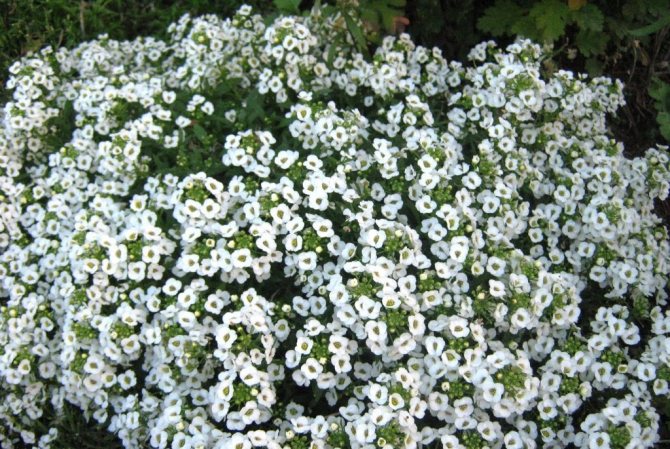

Alyssum cuts well and grows quickly, then blooms again, which makes it possible to make trimmed borders from tall varieties
The unique aroma of honey pleases flower growers alissum, also known as beetroot. In personal plots, both annual and perennial species of this plant can be grown. They bloom throughout the summer.
Pruning flower stalks stimulates re-flowering.
Alyssum buds begin to appear 6-7 weeks after germination. As soon as the first flowers bloom, the garden begins to fill with the scent of honey and cut grass. The smell is persistent and suffocating sweetness, so it is recommended to plant it in open areas.
Borage can be grown in many regions of Russia. It is cold-resistant. Alyssum is not afraid even of spring frosts, he easily endures sudden cold snaps. It is recommended to plant beetroot seedlings in the land in central Russia in the last days of May. It thrives best in sunny garden areas with neutral, well-drained soil. Many plant alissum in compositions on alpine hills, in rocky gardens. It can grow between stones, slabs heated by the sun.
Flowers grow rapidly in breadth, therefore, when planting, experts advise leaving about 40 cm between the bushes. After planting, abundant watering is required. Alyssum should not experience a lack of moisture, but with stagnant water there is a possibility that the plant will disappear.
It is not difficult to care for alissum. The main thing is to water the plant in a timely manner, apply fertilizers. When growing perennial species in the spring, it is imperative to cut off the remaining peduncles, dry leaves, and weak shoots.
Alyssum is a permanent inhabitant of my garden, because it smells very nice and attracts bees and bumblebees to the site. To some, this modest inhabitant will not seem beautiful, but I will tell you this: you do not need to part plants in a flower bed, and then a real white cloud will grow from one root of alyssum. Its main advantage is its simplicity.
My name is Spring
Amorphophallus titanum
Many plants belonging to the amorphophallus species also give off a rather unpleasant aroma, but some of them emit odors, for example, reminiscent of spices or chocolate.
There is one type of amorphophallus, which gives off an awfully unpleasant smell of feces or rotten meat. This is a smelly flower - amorphophallus titanum, which is also the tallest flower in the world. In height, it can reach 3 meters. Its other name is "cadaveric flower". Its usual diameter is 50 centimeters, and its weight is about 50 kilograms.
Until recently, the titanic amorphophallus grew exclusively in the forests of the tropics of the island of Sumatra (Indonesia), but with the arrival of humans in the wild, it almost disappeared. Now it can be seen in botanical gardens around the world. Flowering lasts only one to two days, during which a terrible fetid odor hovers around the plant, more reminiscent of the smells of rotten fish and eggs.
The stinkiest plant
By right, this flower can be attributed to the list of plants with the most unpleasant odor. Its peculiarity is that it is very large.
What is the name of the smelly flower? Sumatra and Java are home to the original Arnoldi rafflesia, also known as the corpse lily. It consists of just one flower. In addition, it has no roots or leaves. This relic has no analogues in the whole world.
The flower is also remarkable for its amazing brilliance. It consists of rather fleshy, thick petals of a rich red color with outgrowths of white shades in the form of warts. Undoubtedly, rafflesia is not only a beautiful smelly flower. It is also the largest in the world, because its diameter reaches 2 meters, and its average weight is 11 kilograms.
Not many agree that this very smelly flower is beautiful. But the concept of "beauty", as you know, is relative. The aroma of rafflesia is reminiscent of the smell of rotting meat. This property of a flower attracts a huge number of insects to it, for example, flies.
What is it for? The plant does not feed on insects, but uses them in this way for pollination. A fly crouching on a flower, falling in pollen, flies to the same plant - this is how pollination takes place. An interesting fact is that the seeds of the plant are spread by elephants.
Rose (Rosa)
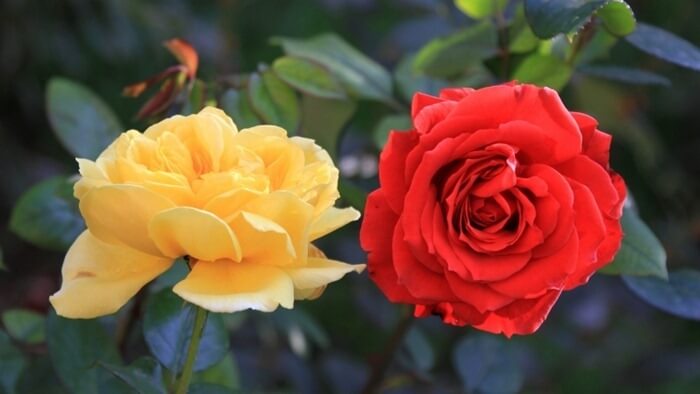

There is no other flower on Earth that can be compared with the beauty and scent of a blooming rose. Depending on its color, it is a symbol of love, passion, nobility, purity, virginity and spiritual revelation. And the rarest rose in the world is the black rose growing in Turkey in the village of Halfeti. Surprisingly, its petals are dark red at first, and acquire a rich charcoal color only towards the end of summer. This is due to the properties of the soil, which is washed away by groundwater at a very high pH level.
There are ten of the most fragrant rose varieties according to the American Rose Society. These include:
- Aida;
- Duftwolke;
- Mr. Lincoln;
- Tiffany;
- Dublin;
- Captain Harry Stebbings;
- Royal Highness;
- Limelight;
- ‘Miss All-American Beauty;
- Folklore.
Flower queens require a lot of sunlight, warmth and frequent pruning, but their wonderful scent more than expiates all the difficulties in care.
Pleasant scent is not always just a bonus
The scent of houseplants is often considered an additional "option", perceived more as a prize or a pleasant addition than as an important characteristic to consider when buying. Meanwhile, the fragrantness of flowers and inflorescences, and sometimes leaves of plants, must be taken into account.
Fragrances affect our well-being, emotional state and even health in different ways, and this effect is not limited to "pleasantness". Perception of smells is purely individual and requires careful selection. In this regard, it is better to treat aromatic indoor crops as a selection of perfumery products or a selection of oils in aromatherapy.The smell of a particular plant should not only be pleasant to you, but really like it, have a positive effect on the psycho-emotional background and not lead to sleep disturbance.
When choosing fragrant plants, one should also take into account how the smell will manifest itself in individual rooms and closed spaces, whether it will be appropriate in specific rooms and corners of the house, whether its intensity will not become a source of unpleasant emotions and poor health. After all, fragrant indoor plants, even if we are talking about the most exquisite variations, can influence us far from only positively.
The selection of plants according to the intensity of the smell in accordance with the purpose of the room is the most important, but not so simple task:
- In the bedroom, anxiety and sleep problems are not caused only by the most delicate, sophisticated, subtle and delicate scents. Plants, the intensity of the smell of which increases at night, will not be appropriate here.
- Sweet, fruity-rich, cheerful aromas of citrus fruits and other intensely smelling plants near by will be appropriate both in the nursery and playroom during the day, and in the office or in the corner for handicrafts.
- All the aromas associated with confectionery, reminiscent of extracts and spices, will be appropriate in the kitchen. As well as plants, the smell of which helps to purify the air and interrupts unpleasant odors.
- Heavy, thick, rich, obsessively sugary and intense aromas of "night" plants can be used only in those rooms, past which you only pass, where you do not rest and do not work in the evening. Such plants, even in the corridor or hallway, can cause a lot of trouble, they most often have to be taken out at night away from bedrooms and living rooms. But at the same time, if you like their scent, it will be more than appropriate in the bathroom or hallway. Yes, both in the morning and in the afternoon, it will become an additional activating factor in any room, help to forget about drowsiness, tune in to a working mood and awaken creative energy no worse than a cup of invigorating coffee.
- All aromatic plants are conventionally divided into sedative and tonic. The smell of the first calms, relieves fatigue, slows down the pulse, allows you to relax and forget about stress. The latter act the other way around - they increase the heart rate, mental activity, excite the central nervous system, increase endurance and performance. Moreover, tonic aromas are found much more often than soothing ones. While the former (sedatives) are appropriate even in places where you rest and sleep, the latter (tonic) can be a source of great trouble in the bedroom and living room in the evenings. But you should not overdo it with both. Check how the plant affects you and consider how it affects you when placing it in your home.
Strong-smelling plants are always appropriate for special occasions. A small fragrant bush of an abundantly flowering plant, set on the table as a living bouquet, is able to transform a festive feast or create a special solemn, romantic atmosphere no worse than the best cut arrangements.
But in any circumstance and with any plant, testing for an individual reaction is still key. At the same time, the correct selection of plants according to your tastes should be supplemented by checking the smell for its acceptability for all family members. After all, even if the smell is not too pleasant for one person, it is not worth starting a plant with an intense aroma.
The best (and easiest) way to test the scent and its tolerance is for those plants that buy in bloom. But this option is not always possible. If you make sure that you like the smell of flowers you cannot during the purchase, before deciding to have a houseplant with a strong smell, be sure to take a closer look at it. Smell flowers from friends, visit the greenhouse, botanical garden or flower exhibition, walk through the flower shops.Before you bring such a plant into your home, you must make sure that its smell will be pleasant to you. It is advisable to conduct this assessment even before all other criteria for purchasing plants have been assessed.
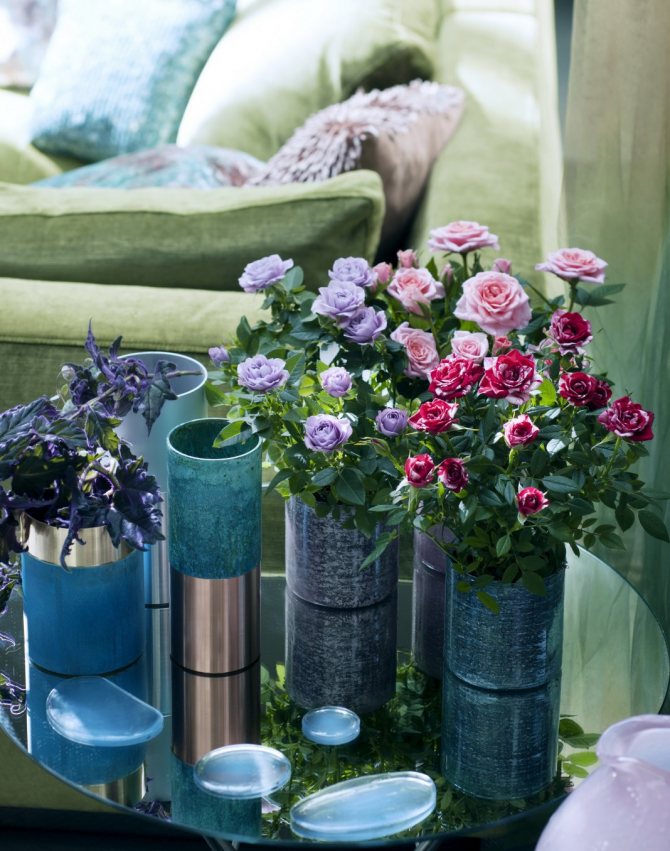

Roses in the interior
Night beauty (Mirabilis jalapa)
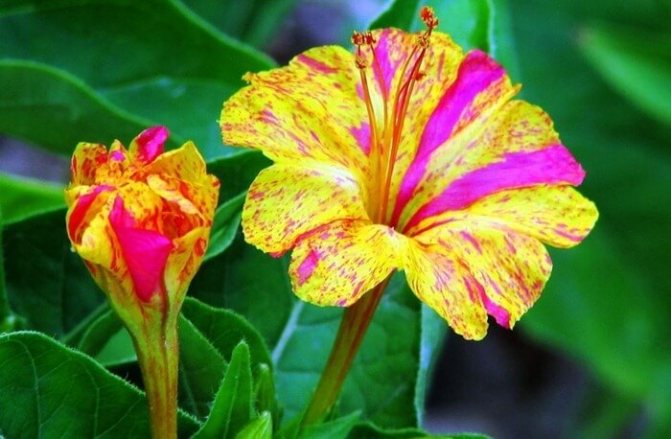

This plant has another name - Four o'clock - which gives an idea of its main feature. The flowers of the night beauty open in the middle of the day and remain open throughout the night.
Usually gardeners plant the night beauty in the patio or close to the windows in order to enjoy the pleasant smell, which is strongly felt in the evening. The plant is unpretentious, can grow both in the sun and in the shade, and needs very little water.
Exotic scents.
I would call the queen of room fragrances. The subtle refined smell of even one flower very pleasantly aromas the room, giving it an oriental flavor. Great for living rooms.
The place for the gardenia should be bright and with a constant temperature, watered only with soft water.
A strong aroma comes from hoya flowers, or as it is also called, from wax ivy. The plant is easy to propagate by cuttings, it is advisable to find a place for it in a shaded part of the house. Unpretentious plant, very hardy.
Watering is done less frequently than other plants. In the bedroom, this flower is definitely not suitable, since the smell intensifies towards night, and not everyone can sleep in such a room.
Stephanotis, or Madagascar jasmine, has a very refined scent. The white waxy flowers of this vine smell like a mixture of jasmine and ylang-ylang. A very noble and sophisticated smell and not annoying.
It is undesirable to place several plants with a strong aroma in the same room. The maximum number of flowers with a strong aroma in one room is two flowers in opposite corners. At the same time, airing the room should be done daily so that the aroma is always fresh.
The most fragrant plants for the home
Indoor flowers, which have a bright smell, are divided into 2 categories: some emit a bright aroma only during the flowering period, while others always exude a pleasant smell.
So, let's get to know these beauties as soon as possible!
Blossom and smell
Stefanotis
His middle name " Madagascar jasmine
“, This plant requires careful care, it belongs to shrub vines, blooms with small flowers that look like stars. Loves good lighting, gives a bright aroma during the entire flowering!
Eucharis
It is also called “Amazon lily
“, She exudes an incredibly delicate, delicate aroma. This is a perennial flower, several times a season it will delight you with beautiful flowers that resemble daffodils!
Photo:
It is quite difficult to grow it in an ordinary house. This tropical beauty is quite capricious, she adores light, humid air and warmth, but cannot stand direct sunlight.
Hoya
This plant has a bright sweetish aroma, which intensifies in the evening. It is also called "Wax ivy
“It is very easy to care for and is drought tolerant. It blooms with round umbrellas with small white flowers, in the form of stars, with a red center.
Photo:
This beauty is quite unpretentious in care. Possesses a strong fragrant aroma, it blooms with magnificent pink and snow-white flowers.
Muraya
It can bloom for a whole year! Its aroma is delicate, fresh, exquisite, blooms with white flowers, similar to lilies. This shrub can be easily turned into a small tree and grown at home.
Always smell
Myrtle
This evergreen plant will be a real freshener for your home! And the leaves and stems of myrtle spread a fresh scent around.
Araucaria
Photo:
This plant fills the air with phytoncides, filling the space of the house with a soft coniferous aroma. It is easy enough to grow in the house.
Plectrantus
It is also called "Room mint
“The leaves of the plant are very pretty, and its leaves and stems exude a fresh mint scent. It blooms with small lilac or white flowers, and its smell even scares off moths!
When choosing a plant for your home, remember that too bright scents are not suitable for bedrooms.
The smell of a house is made up of a lot of scents. Among its components there are also various types of flowers, the delicate scent of which is a worthy alternative to air fresheners and interior perfume. When choosing smelling houseplants, it is important not to overdo it. Heavy smells or an overabundance of spices are not the best for creating home comfort. It is also necessary to take into account the fact that among the flowers with a bewitching aroma there are conventionally poisonous ones, the constant proximity with which in a closed space is undesirable. For different rooms inside the house, the choice will not be the same.
Indoor flowers for the bedroom
Geranium is beyond competition, the leaves of which exude a pleasant aroma. Their smell in different varieties is not the same: from mint to chocolate.
Myrtle also has a beneficial effect on humans, which has a unique ability to purify the air, while exuding a light pleasant smell.
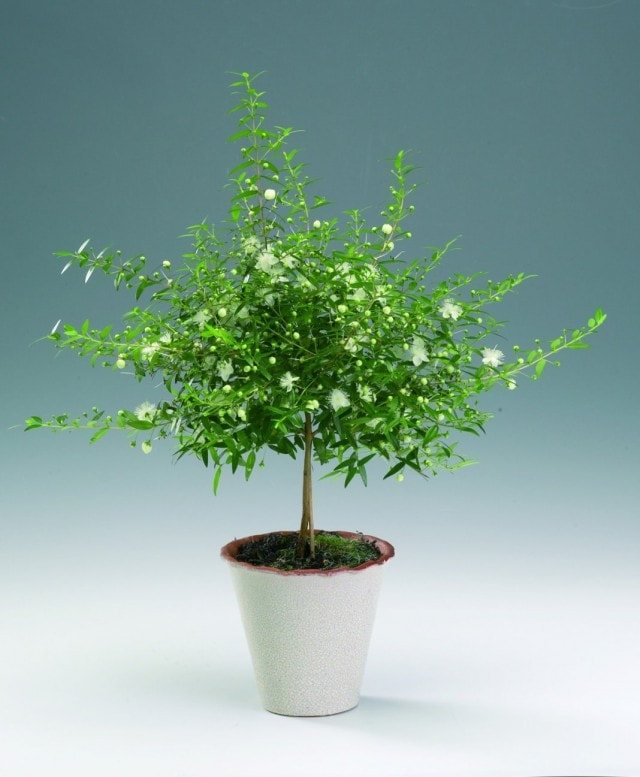

Plectrantus will also help to forget about insomnia. This flower has other names: Cuban oregano and Mexican mint. The plant is unpretentious in care, has a pronounced mint smell. Can be used as a spice.
Lavender is also good for the bedroom, but it will require specific care, which beginners do not always manage to cope with.
Citrus fruits can also be placed in the resting place.
Flowers for the foyer and living rooms
Gardenia looks great, but does not tolerate drafts. Its rich floral scent is good for those rooms that are not supposed to sleep.
Orchids also feel great in the living room, although fragrant varieties are rarely found on sale. In nature, the orchid is a "imitator" of odors. Her signature scent is vanilla, but this beauty can smell like rose, lily of the valley and even coffee.
Indoor roses are always appropriate in the living room. And even though they are much smaller than their garden relatives, this does not diminish their dignity. This flower will not tolerate battery placement.
Indoor fragrant plants in the kitchen
Catnip, rosemary, peppermint, laurel, thyme - this is not a complete list of plants for the kitchen. The spicy aroma of herbs will only come in handy here; if you wish, you can even plant dill with parsley on the windowsill.
Many plants attract the attention of a wide variety of insects and people with their charming beauty and luscious aroma. But it so happened that in nature there are species with a rather unpleasant, even disgusting, smell.
After reading this article, you can find out about the name of the most smelly flower in the world and what it is. We will also tell you about what other flowers with unpleasant smells exist. Below are descriptions of some of the more eye-catching ones.
Popular garden flowers with a strong scent
For the summer residence, fragrant annuals and pleasantly smelling perennials can be used. To get a spectacular and fragrant flower bed for a long time, you need to know what the most unpretentious garden plants form a fragrant flower.
The most fragrant flowers for the garden
Garden fragrant flowering crops can be annual and perennial, which allows you to create attractive compositions:
- sweet pea - an annual plant with a pleasant pronounced odor. Differs in a variety of colors, which helps to create front gardens or pots in different styles and colors. Varieties and hybrids of the bush type look spectacular on flower beds and ridges;
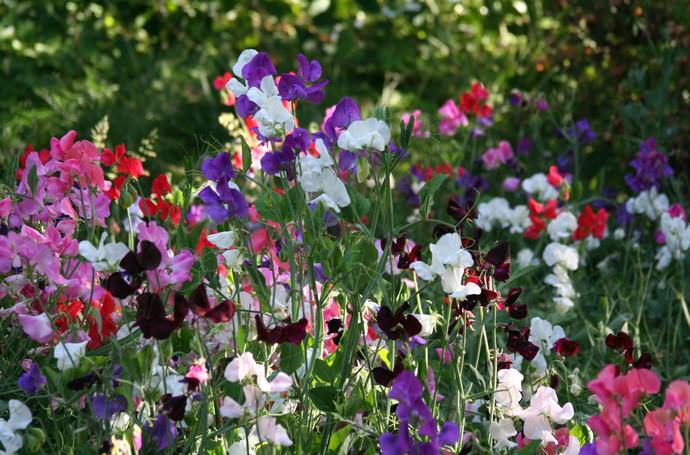

- flowers Alyssuma or sea lobularia smells like honey and are not afraid of spring frosts, therefore they are ideal for growing in cold regions;
- undersized Lily of the valley grows well in the shade.This perennial plant forms small flowers, and goes well with peonies and carnations;
- the most common daffodils white-colored and yellow-colored varieties have a very delicate and very refined aroma, which new varieties and hybrid forms are devoid of;
- spring Hyacinths especially popular in early flower beds and flower beds. The plant is represented by numerous varieties with all kinds of flower colors, which allows you to choose the best option for decoration;


- shade-loving viola it is best to sow before winter, which improves resistance to negative weather factors. This is an ideal solution for decorating difficult-to-cultivate areas and tree-trunk circles of garden plantings;
- many varieties Carnation They are distinguished by flowers with a persistent scent that can effectively repel mosquitoes and many plant pests. The most unpretentious types are lush, blue-gray and feathery carnations.
Lilies, roses, chrysanthemums and peonies blooming profusely with fragrant flowers are no less popular with gardeners.
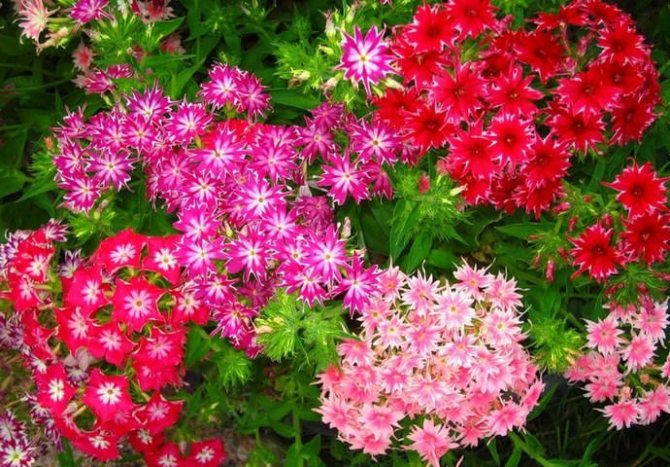

Flowers that smell at night
The flower, fragrant in the evening, is popular in the design of the backyard and flower beds located in the immediate vicinity of the house. Night flowering plants or ornamental crops that smell amazing at night:
- tropical annual Mirabilis able to bloom profusely throughout the summer season, and forms deliciously smelling delicate white, pink, red and yellow inflorescences that open in the evening;
- evening relatively small fragrant flowers tobacco not only attractive but also very aromatic. The most popular varieties include winged, forest, and jasmine;
- name Mattiola known to many amateur flower growers. This annual opens flowers to smell in the late afternoon and does not tolerate sunny areas, therefore it is sown in flower beds and in flower beds in the shade of lilac or dahlia;
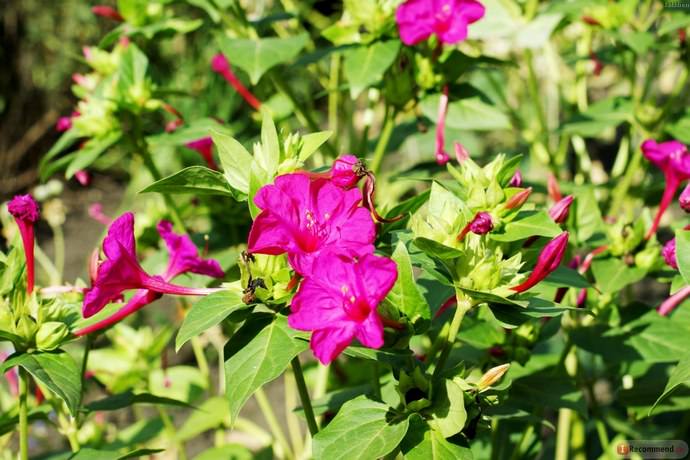

- flowering Levkoy is a relative of mattiola, but a significant difference is represented by magnificent flowers that have many shapes and colors;
- garden Fragrant mignonette especially highly appreciated by landscape designers for the beautiful shape of the leaves and the pleasant unusual aroma that persists at night;
- night violet or female hesperis - the most common decorative type of violets in home gardening, characterized by abundant flowering and a characteristic pronounced aroma.
The annual Moonflower is best suited for decorating an evening garden, and its delicate aroma intensifies after sunset. The plant is best suited for areas with hot and sunny climates.
Fragrant flowers for the garden (video)
Spicy herbs and scented plants
Spicy-aromatic fragrant plants with characteristic healing properties are widely cultivated in most regions of our country. The most popular plants are:
- Peppermint, long-leaved, curly, garden and apple is perfect for growing in garden plots, and is a valuable ingredient in salads, soups, meat dishes, various drinks and homemade baked goods;
- Melissa medicinal is a popular perennial essential oil herb called lemon mint, which is due to the pleasant scent of lemon, which remains in the plant even when dried;
- Catnip or catnip - a culture that is not only useful, but also very decorative, thanks to purple or lilac flowers, as well as grayish-blue leaves;
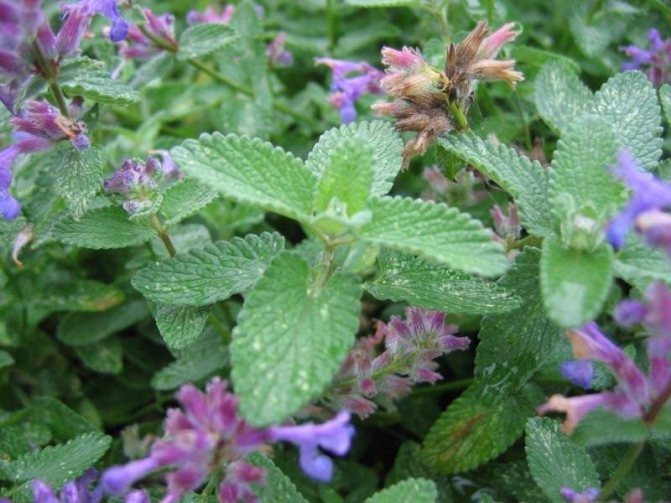

- Oregano or origano refers to a beautiful ornamental plant with a very pleasant aroma that intensifies on sunny days. The flowers are attractive lavender or pinkish;
- common, creeping or lemon Thyme known as thyme or Bogorodskaya herb and has a delicious smell as well as a spicy taste;
- Hyssop or St. John's wort blue refers to a subshrub herb with a tart taste that blooms with attractive spike-shaped blue inflorescences;
- essential oil and decorative Monarda or garden bergamot refers to medicinal and flavoring plants, and cut bright red, pink, white or purple flowers are great for composing.
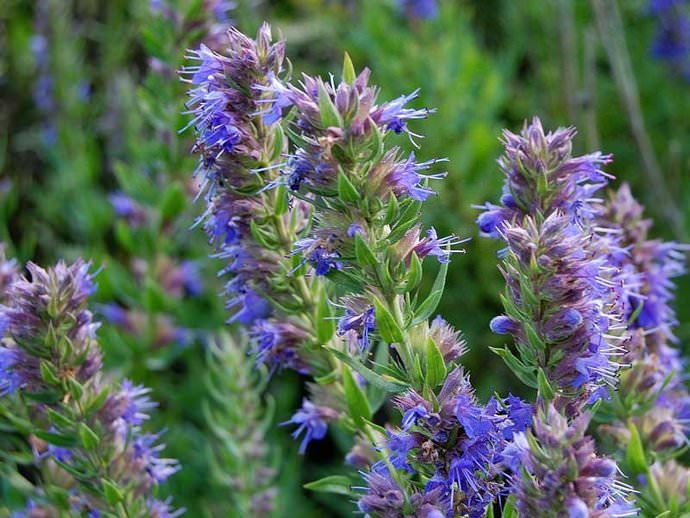

- medium-sized spicy-aromatic Lovage has very beautiful leaves of the pinnately dissected type and can become a real decoration not only for garden ridges, but also for flower beds;
- perennial spicy Fennel has bluish-green split leaves and a characteristic, very pronounced smell of anise, due to which it is widely used in soups, vegetable, fish and meat dishes;
- Tarragon known to many under the name tarragon. The leaves of this medium-sized plant are widely used in a variety of French fish dishes and poultry.
No less popular among domestic gardeners and gardeners are such spicy and aromatic crops as dill and basil.
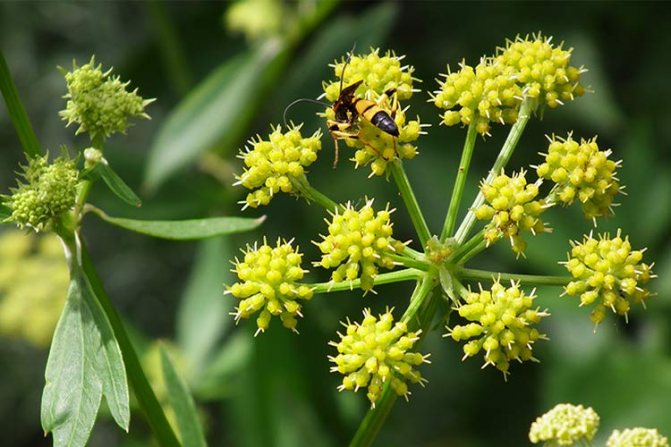

Mattiola
The cultivation of matthiola (levkoy), originally from the Mediterranean and southern European regions, pursues a specific goal - the aromatherapy of the site. During the day, other flowers are fragrant in the flower garden, and in the evening the main role goes to mattiola - flowers closed during the daytime open and exude a pleasant aroma, filling them with all the space around. Therefore, beautifully smelling flowers are planted near gazebos, terraces, along the paths in order to fully enjoy the aroma on an evening walk.
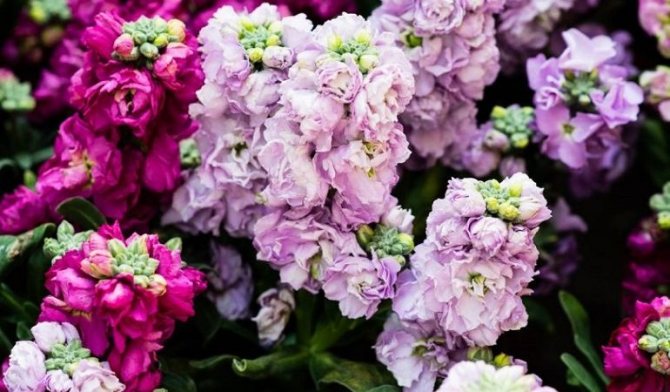

Reference! Another name for the flower "night violet" conveys its distinctive feature - flowering at night.
Unusual flower facts:
- the aroma of the flower scares off pests, so it is recommended to plant a flower next to potato plantings;
- in the Middle Ages, the levkoy was valued in the same way as the rose and the lily; later it gave up its positions;
- alcohol tincture of matthiola leaves has antibacterial properties.
Gardenia jasmine
Jasmine gardenia has long been cultivated at home as a beautiful ornamental plant in the form of a low bush with dense green leaves and large white flowers. A native of Japan, China, India, it has firmly established itself in a temperate climate and is very popular among lovers of original indoor plants.
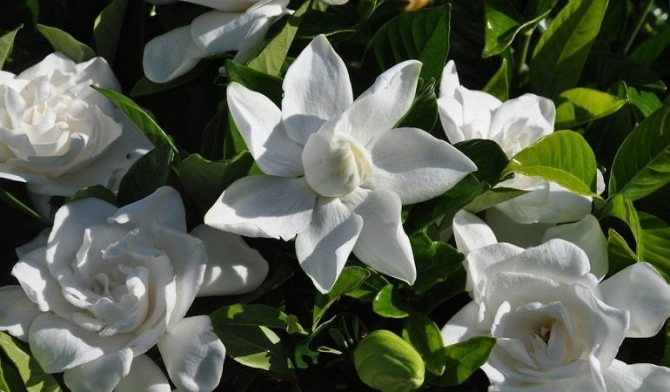

A distinctive feature of the culture is not only a decorative appearance, but also a breathtaking aroma of flowers that smell like a mixture of vanilla and cinnamon. The scent of gardenia in the cold winter season brings back memories of summer and romantic evenings.
Interesting facts about gardenia:
- many perfume brands, for example, Nina Ricci, Chanel Gardenia, Dior Miss Dior, use the scent of gardenia jasmine;
- the substances contained in plant phytoncides have a calming effect on a person, improve mood;
- the flower is used to attract the attention of the opposite sex (powder from dried flowers is rubbed into the skin before meeting);
- fruits and roots are used in traditional medicine recipes.
Scented tobacco
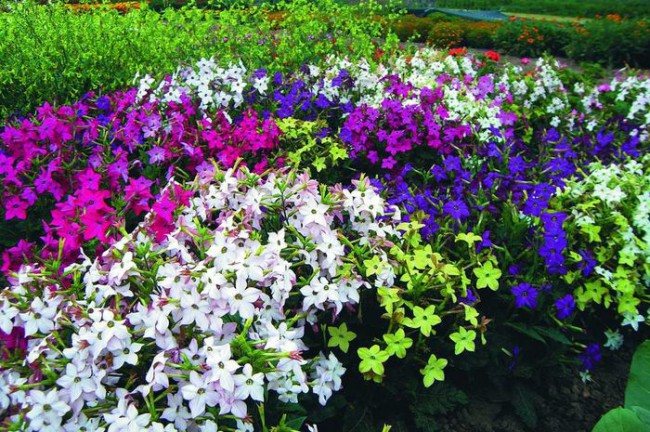

This annual plant prefers planting in groups, while its aroma is especially active in the evening. Flowers can be not only white (the most fragrant type), but also yellow, pink, deep crimson, red, light green. The plant feels comfortable in partial shade and in the bright sun, gives flowers from July to October. Also, gardeners note a particularly fragrant variety of scented tobacco - Forest tobacco.
Fragrant perennials
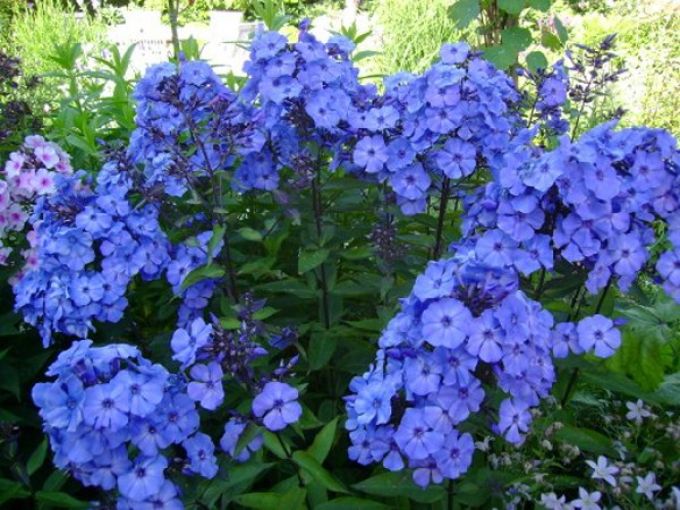

Phlox - the perfect design for garden paths
A fragrant garden throughout the summer will be provided by bulbous and corm perennials:
Spring blooms and a pleasant scent are essential after a long, cold winter.
Basically, bulbous flower varieties delight in the spring:
- Lilies of the valley - "hello first of May" grow beautifully in the shady corners of the garden.Often planted in combination with aromatic plants of a later flowering period, such as peonies or carnations;
- Daffodils - only the most common varieties of white and yellow, delight with a magnificent delicate refined scent. Varietal daffodils, of course, are beautiful, but they do not smell at all;
Advice. A daffodil can grow in one place without a transplant for up to three years. It is necessary to plant the bulbs as the bud size decreases.
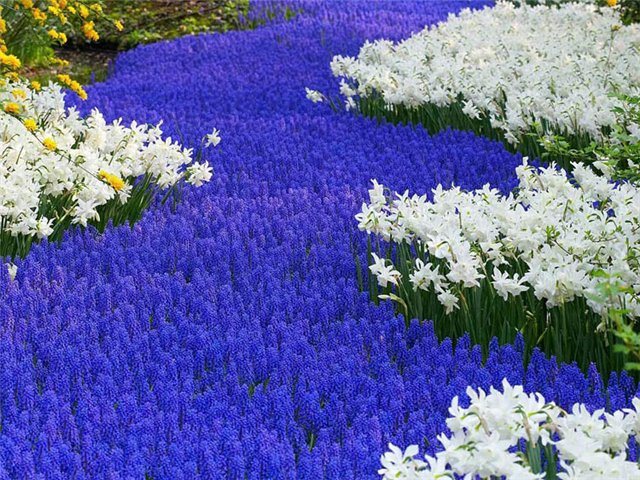

Spring "river" of flowers
- Hyacinth - a spring flower bed is simply impossible without hyacinths. The heady aroma of this flower awakens imagination and fantasy, but it is not recommended to keep bouquets of hyacinth in the house, severe headaches and pressure rise may occur;
- Violets love shady areas, and quickly die in direct sunlight. This flower is ideal for difficult-to-cultivate areas under fences and in tree-trunk circles.
Advice. It is better to sow violets with seeds "before winter" so that the plant hardens.
A lush summer flower bed or a front garden with a swarm of butterflies hovering over it is a snap:
- Cloves - there are a lot of aromatic varieties. They are not as large as the familiar carnations from the store, but their smell repels mosquitoes and other pests. Therefore, the gardener's instruction recommends planting these flowers near gazebos and other resting places at their summer cottage. The most unpretentious varieties of summer carnations are lush, grayish-blue, feathery.
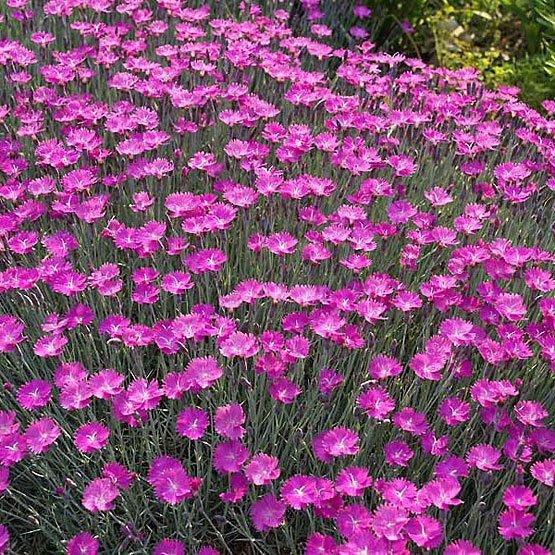

Pink scented carpet
Advice. It is better to plant cloves with seedlings, and not with seeds, since you will have to wait a whole year for seedlings after planting. And the bush grows over the summer into a lush fragrant green carpet.
- Irises - there are varieties with a surprisingly delicate, pleasant aroma. These are yellow, yellow with a white center and purple irises. The flowering period is July and again the end of September, October, depending on the region;
- Roses are the queens of any garden. The most unpretentious and disease-resistant varieties with an unsurpassed aroma are Hanza and Delikat, respectively, purple and pink in color. These varieties bloom almost all summer and are resistant to powdery mildew. White inflorescences of the Alba variety, of medium height, amaze with a stable, persistent, rich pink aroma.
- Lush bright peonies delight with a sweet spicy aroma and are great for decor in the summer cottage of the center of a flower bed or flower garden;
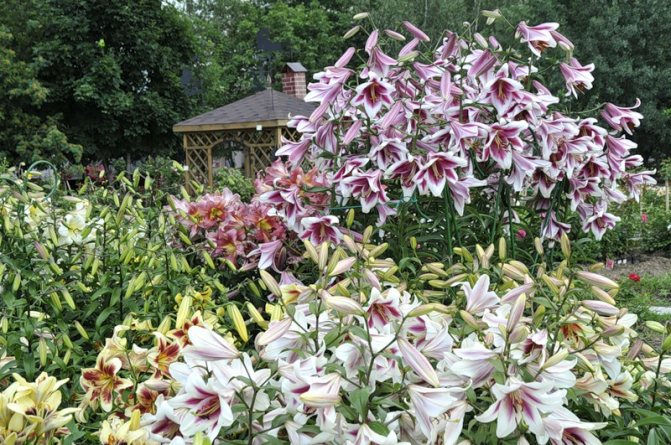

Aristocracy and refinement
- Lilies - these refined elegant flowers do not please us for very long, but many love their magnificent riot and delicate scent in mid-July. White lily is also used as an alcoholic tincture in folk medicine as an ideal antiseptic, wound healing and skin rejuvenator. The price of the rejuvenating tincture is a bush of graceful white beauties in the composition of a summer front garden.
Advice. Lilies look very beautiful in a composition of irises and small daisies. Especially if the garden bed is decorated in the Provence or Mediterranean style.
In autumn, there are not many flowers that can delight you with a pleasant scent, but chrysanthemums are beyond competition. This cold-resistant perennial will decorate the garden on cloudy autumn days.
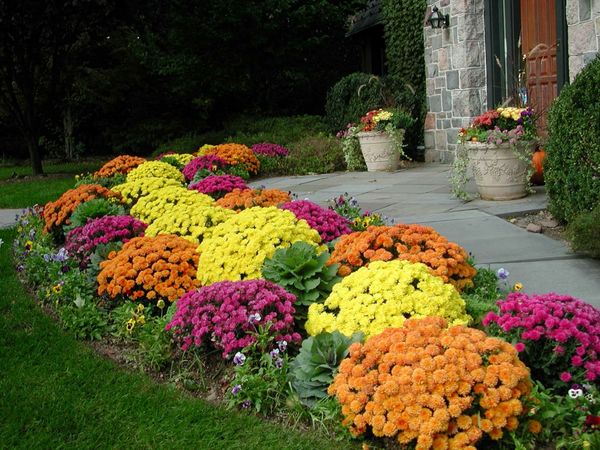

A good idea for a bright border
Interesting. Chrysanthemum leaf salad has unique anti-aging properties, as it accelerates the metabolism of all cells.
But not only flowers can bring pleasant smells to our garden.
There are many unpretentious aromatic herbs that can be easily planted with your own hands, and that do not require constant painstaking care:
- Peppermint and round-leaved varieties. An excellent addition to fragrant tea or exotic summer salad;
- Lavender - a delicate purple bush covered with frost is considered a healer of any garden, used in herbal sedatives and as a remedy for moths;
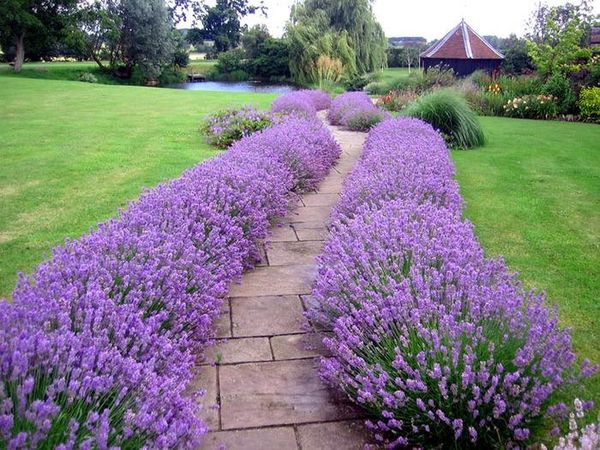

Fabulous lavender path
- Lovage - a frost-resistant fragrant bush pleases with beautiful foliage and is often used to prepare medicinal broths when rinsing hair;
- Rosemary is a fragrant seasoning and a beautiful Christmas tree in any flower bed (requires shelter for the winter when frosts are above 15 degrees).
Benefits of fragrant indoor plants
As a rule, the best scented indoor plants have a beneficial effect on the atmosphere in the room, not only in terms of filling the house with their pleasant trail. In addition to the purely sensory sensations, such plants bring considerable benefits in other aspects. Even those cultures that are classified as poisonous and require careful handling during transplantation, placement in places inaccessible to children and pets, still have a beneficial effect on the air in the room. And even their talents are not limited to a pleasant smell.
Almost all crops, the leaves or flowers of which have a pleasant aroma, emit more than aromatic substances into the air. Such crops can also have other, less noticeable effects:
- they regulate the level of humidity in the room;
- aromatic crops effectively reduce noise and regulate the electrostatic field, increasing the content of negatively charged light ions in the air;
- secrete together with essential oils and other volatile compounds phytoncides, which have a disinfecting effect.
The phytoncidal effects of aromatic plants lead to a decrease in the number of various microorganisms, fungi, bacteria and viruses, healthier air, purification of it from pathogenic and invisible threats. Such plants, influencing the reproduction and growth of bacteria and viral pathogens, help to strengthen the immune system and maintain health.
Certain cultures demonstrate particular efficiency, showing themselves more strongly in the impact on certain dangerous groups of microorganisms. For example, myrtle effectively fights streptococci and staphylococci, pelargonium - also with E. coli and fungal spores. Oleander and other fragrant plants exhibit similar properties.
In addition, almost all indoor cultures are:
- as insect repellents (the aroma of such crops helps fight mosquitoes, fruit flies and other annoying and unwanted inhabitants of our homes);
- they absorb toxins, heavy metals, allergens and help purify the air.
Let's take a closer look at the best scented houseplants, favorites, both in terms of the pleasantness of the aroma and the usefulness of the impact.

